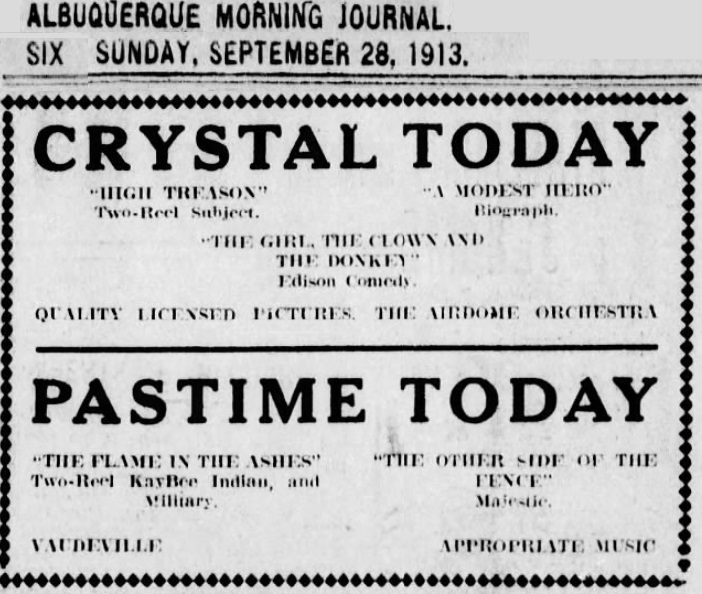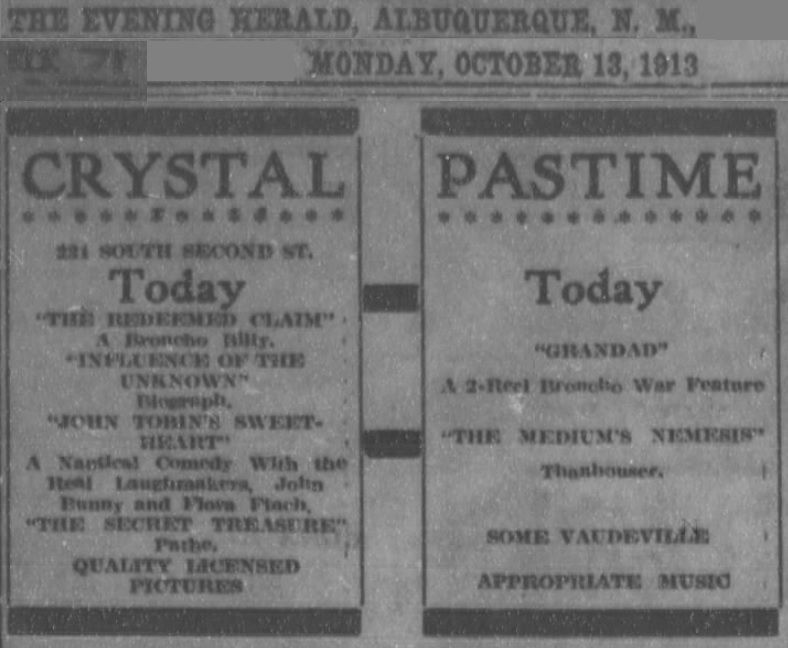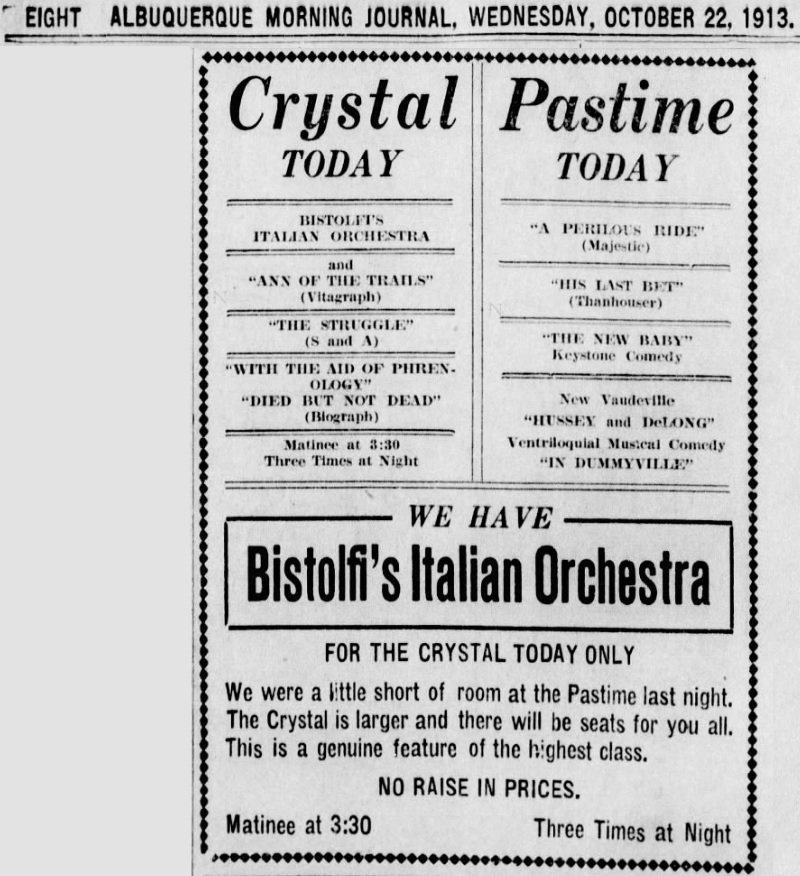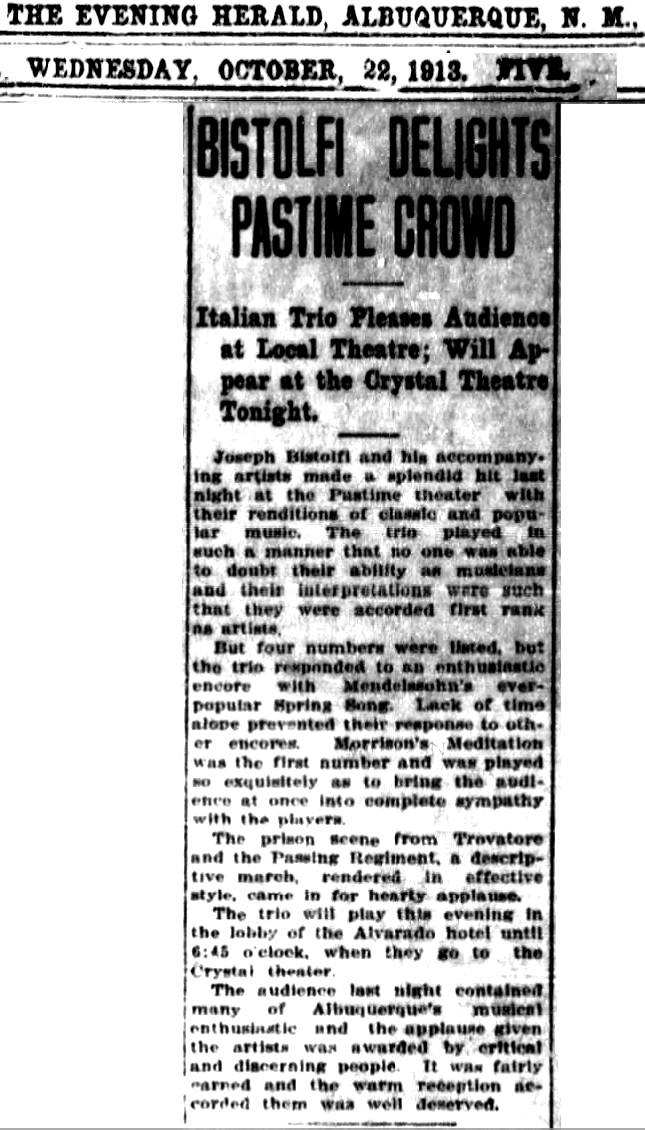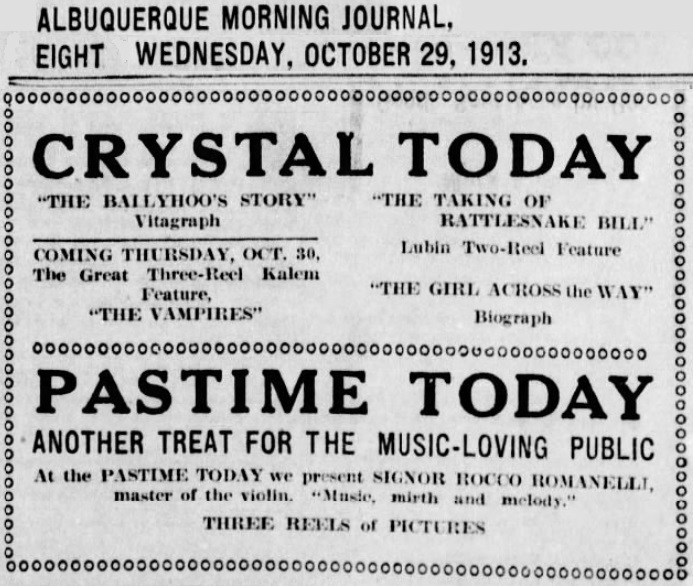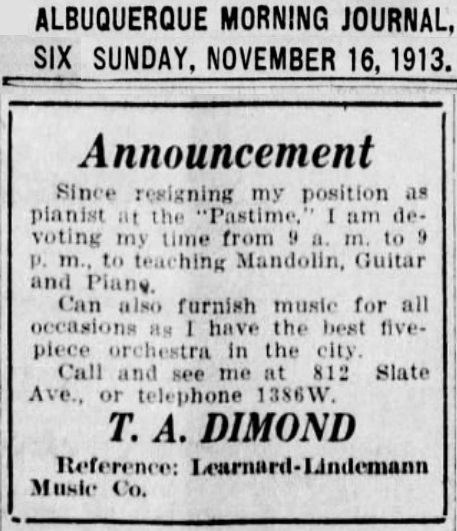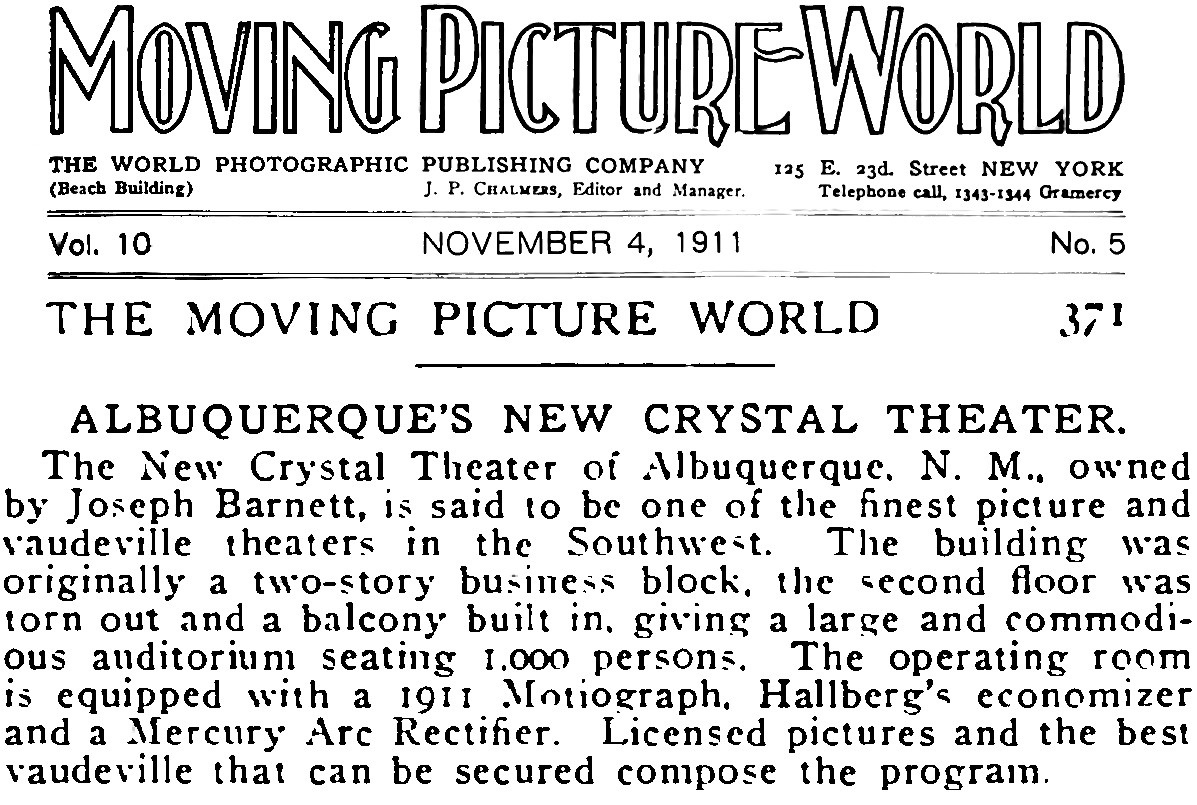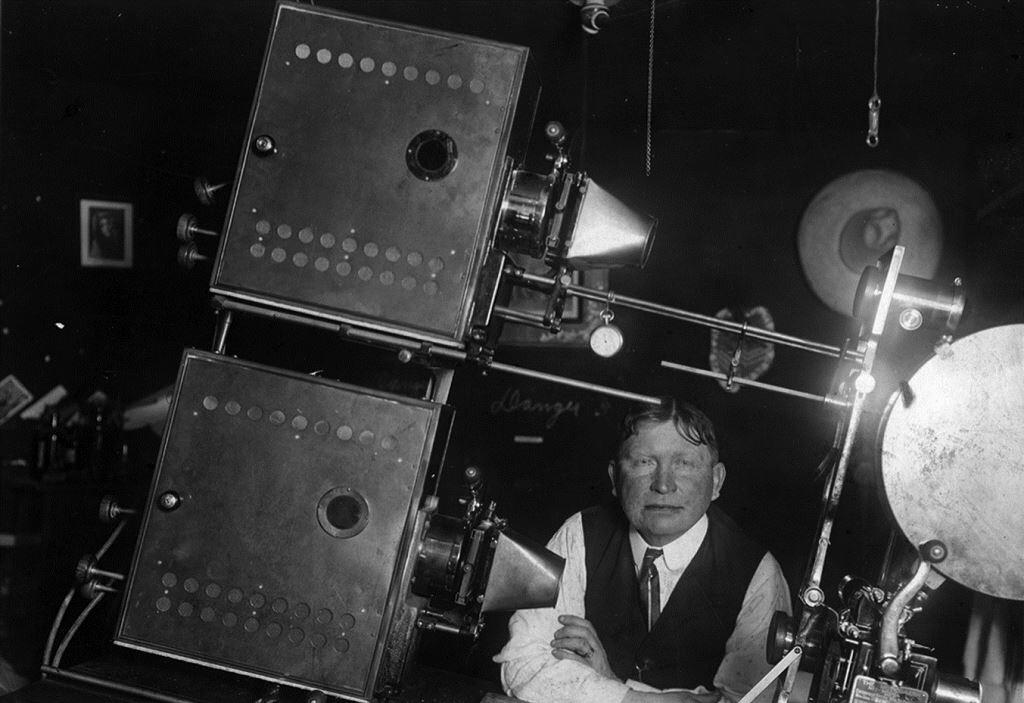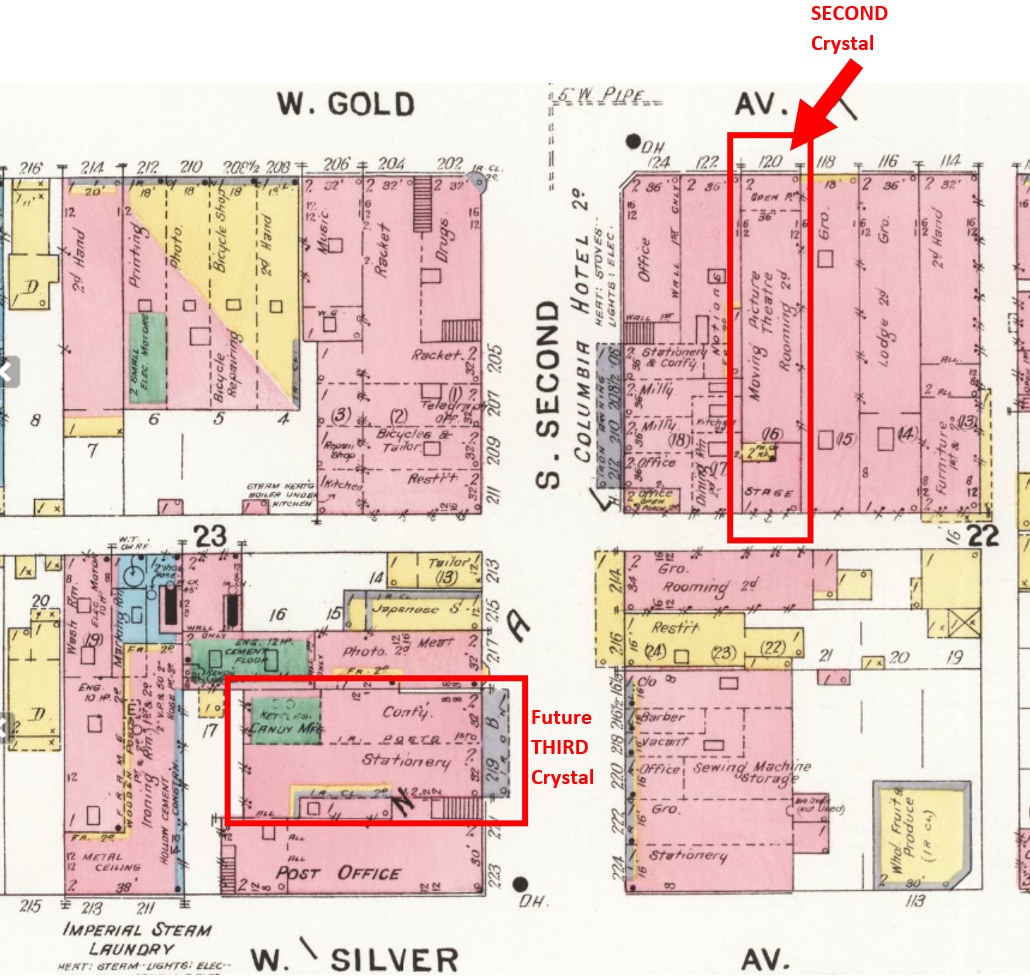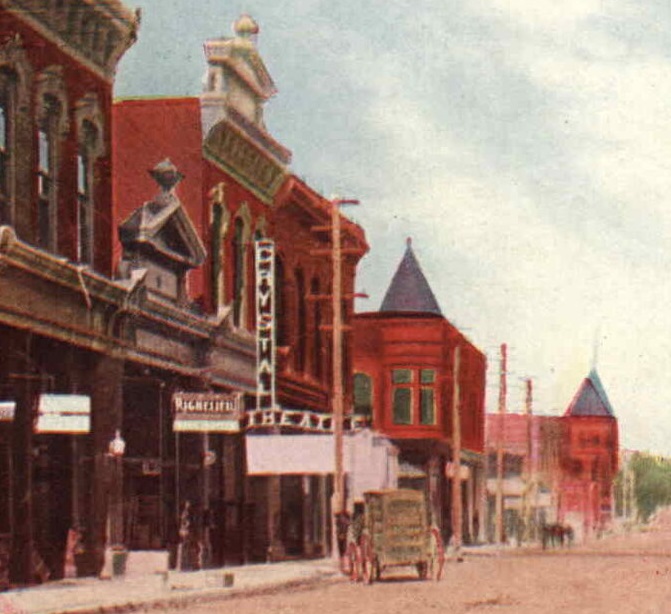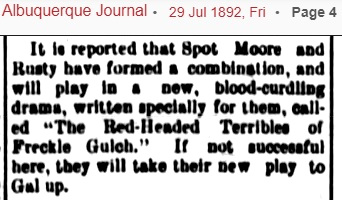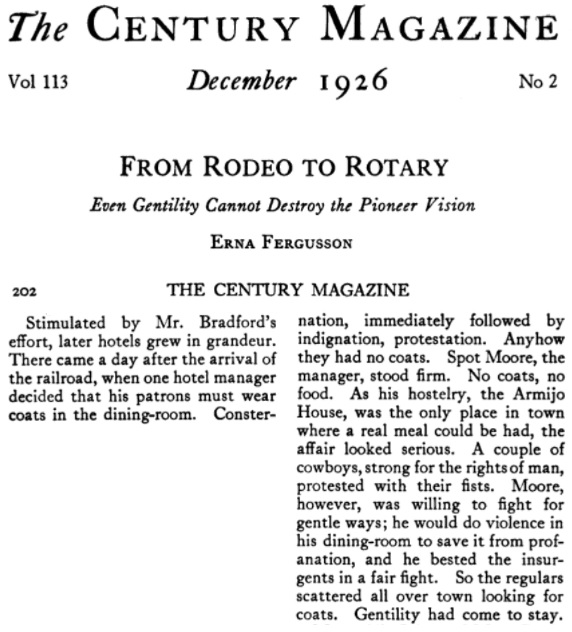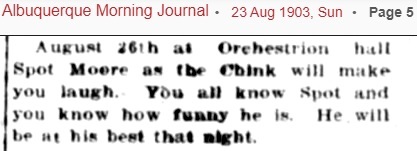Chapter 56
Pastime, Crystal, B
Pastime, Crystal, B
Because of the scribblings above, I got curious about when Charlie Chaplin’s early movies first showed in Albuquerque.
Well, one thing led to another, and so here you go:
a massive sidenote about three of the places where Albuquerqueans watched movies in the early days.
Let’s start with a snippet from the August 1919 Sanborn Insurance Map:
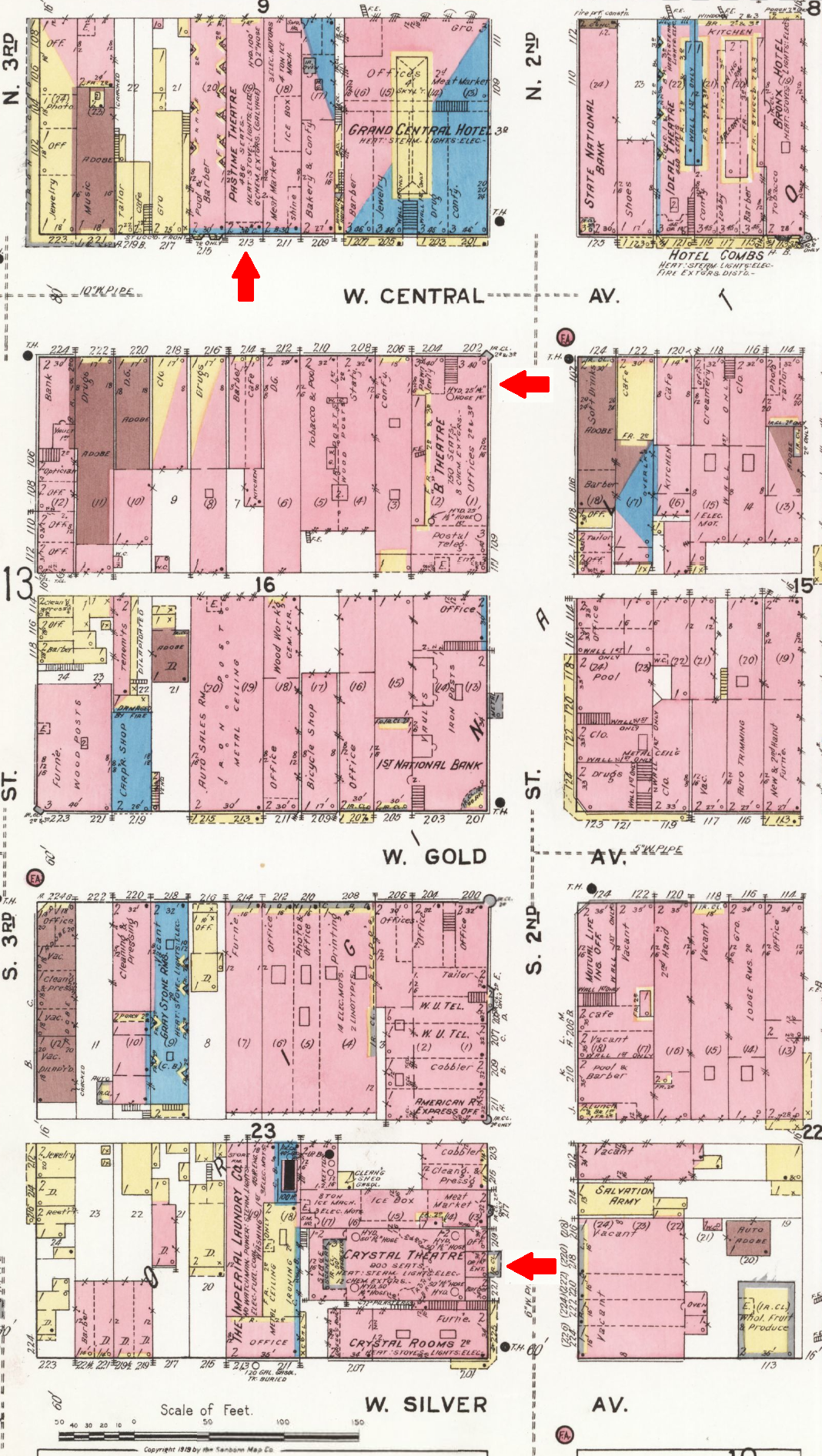
Grabbed from the Library of Congress site.
August 1919 Sanborn Insurance Map showing the Pastime (1909), the (third) Crystal (1911), and the B (1915).
A Nickelodeon Show
My wild psychic intuition is that not a single one of you has ever attended a nickelodeon show back circa 1910. Right?
Well, what was it like?
Below, we have an example, restaged by the then-good folks at Bell & Howell.
The good folks at PeriscopeFilm
uploaded this wonderful item for us on 26 February 2025:
For the full film, click the title: BELL & HOWELL FILMOSOUND 202 PROMO FILM 16mm MOVIE PROJECTOR w/ MAGNETIC SOUNDTRACK GG45075.
When YouTube disappears this video, email me.
Oddly, the film excerpted in the clip above, Revenge on the Range, is from 1925, not 1910,
though it sure looks much more like 1910 than 1925. Very crude.
The Pastime Theatre
At 213 Central Ave NW you can see a brick structure called the
Pastime
Theatre.
Not evident in this edition of the Sanborn, but quite clear in the earlier
May 1913 edition,
is a small stage at the north end.
The Pastime replaced an earlier
wood-frame bakery.
The Pastime was, as far as I know, the first building in Albuquerque specifically designed to house a cinema,
and its opening was on 1 September 1909.
The building was about 25 feet wide by about 145 feet deep.
The stage was about 20 feet deep, the orchestra-level auditorium (including orchestra pit) was about 80 feet deep,
and the lobby was about 45 feet deep.
I can’t be sure, but it seems there was a stadium-style balcony, not overhanging the orchestra level, but behind the orchestra level.
So, think about it, it was really small.
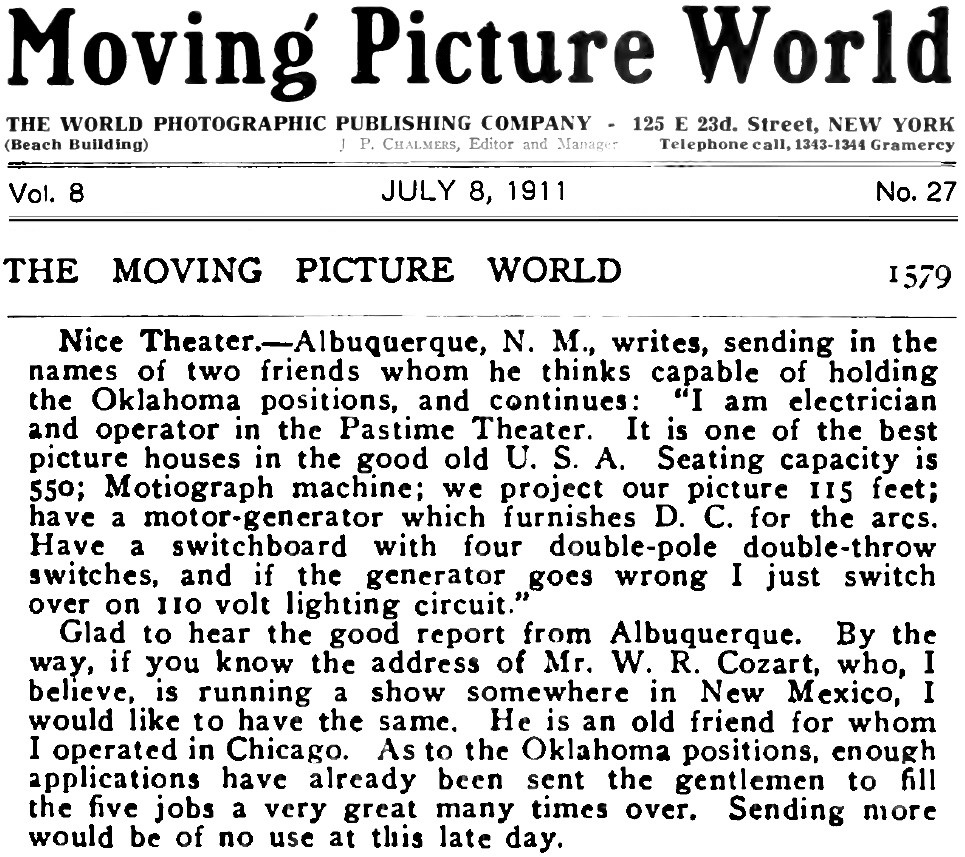
So there we have it: Pauses between each reel, with glass slides projected upon the screen.
550 people crammed into that tiny little space. By the way, Cozart and his brother operated the short-lived Bijou in Las Cruces (1911 through early 1912), and that is yet another cinema that is nowhere mentioned by Cinema Treasures.
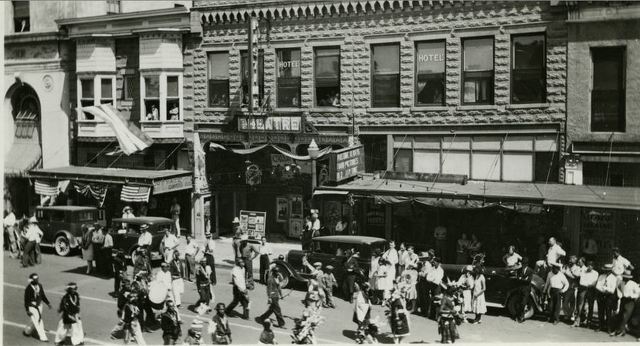
Grabbed from CinemaTreasures.org
This is the Pastime, a cinema with a small stage.
In 1925, the stage was enlarged to become a vaudeville house.
It stood at 213 Central Ave NW and was demolished to make way for the State.
Until I find a sharper copy of this photo, I shall not be able to determine its date.
As we can see, the frontage duplicates that of 211 Central Ave NW,
and so I would guess that both properties had the same owner.
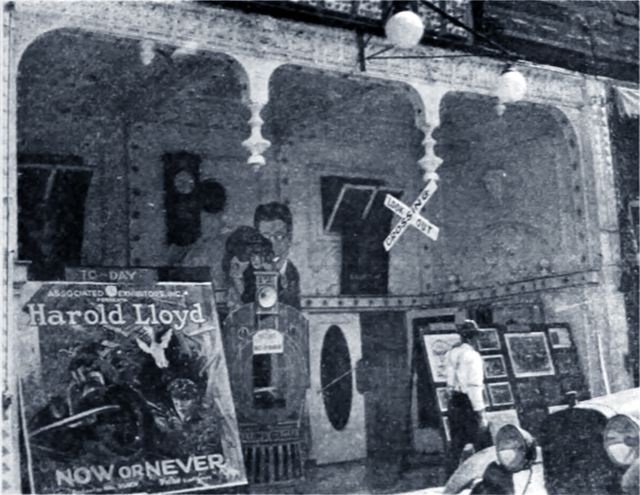
Grabbed from CinemaTreasures.org
Photo taken circa 23 or 24 or 25 June 1921.
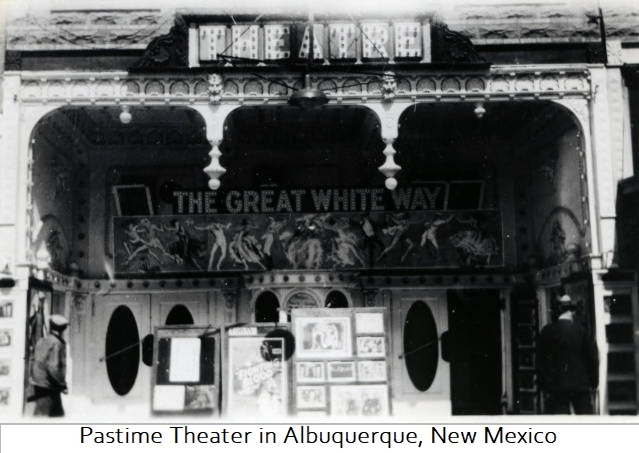
Grabbed from CinemaTreasures.org
Photo taken on 1 October 1924.
The Crystal Theatre
Now, take a stroll two blocks south on 2nd St and you will stumble upon the (third) Crystal Theatre (aka Crystal Opera House).
That was at 219 2nd St SW.
It was not the first Crystal.
It was not the second Crystal.
No no no no no.
It was the third Crystal.
I know. It’s confusing, and I was confused for the longest time.
Cinema Treasures remains confused about it, and so do other online sources.
The first Crystal had been an open-air cinema (maybe in a tent?)
probably at 402 2nd St SW but maybe at 314 2nd St SW.
That was a temporary stop-gap measure while a shop was being hollowed out to create the
second Crystal,
a storefront nickelodeon at
120 Gold Ave SW.
In April 1911,
Joseph Barnett purchased both the Pastime and the Crystal from
R.G. Munn
and George Hammond of Denver,
and he decided that he wanted a better Crystal.
So he ordered a third Crystal, which Henry Trost carved out of a previous
confectionery and stationery.
That was in 1911, and it had a full stage to host touring companies
as well as a proper set-up to show movies, right from the get-go.
Because I know you’re all twisted up now, dying of curiosity:
Motiograph 1 A (and another and here’s a 1916 production run of the exact same machine)
Hallberg DC Economizer
Mercury Arc Rectifier
Motiograph 1 A (and another and here’s a 1916 production run of the exact same machine)
Hallberg DC Economizer
Mercury Arc Rectifier
I have never seen a photo of the exterior of the (third) Crystal.
If you dig out your copy of Byron A. Johnson and Robert K. Dauner’s
Early Albuquerque: A Photographic History 1870–1918 (Albuquerque Journal and Albuquerque Museum, 1981)
and turn to page 176, you can see a photo of some actors on the very small stage, circa 1912.
If you look a little more carefully, you can see bits of the house curtains, the orchestra pit,
an upright piano, and a bit of the proscenium arch.
The building does not look well-constructed, not in the least.
Kathryn Kennedy O’Connor described it in her Theatre in the Cow Country
(Albuquerque Little Theatre / Creative Service for Publishers, 1966), on pages 22 through 23:
|
...But in July 1927, when we first came to Albuquerque,
there must have been a dry spell as far as the theater arts
were concerned because very little was offered in the way of
English theater. But there was the typical Western Opera
House, such as every mining town in the West once aspired
to erecting: the Crystal Theater. It was old and drab and
shabby when we saw it, but it had a glamorous past. Its
name came from imitation cut glass ovals in the heavy oaken
doors that opened into the auditorium from a portal painted
white and festooned with countless clear-glass electric bulbs.
The old theater was still gallantly trying to provide entertainment
for the town though it had been demoted from
“legitimate drama” to second-run moving pictures. It had,
however, seen such fine artists as Madame Schumann-Heink,
and it had also been a regular stop on the Western road-show
route, known in show business as the “Death Circuit.” Many
a tired traveling troupe, sooty from the long railroad “jump”
to get there, had played one-night stands at the Crystal
Theatre. The last of the legitimate offerings was
The Rejuvenation
of Aunt Mary, a trusted vehicle for
Mae [sic] Robson, the
famous character actress. But in 1927, after a showing of
Cecil de Mille’s
King of Kings, when the scabrous ceiling
spilled a lot of plaster on the heads of the few remaining
customers, the place had to be closed by city ordinance and
the curtain came down for the last time with a rumbling sigh.
Worth checking, huh?
The King of Kings ran at the Crystal on
Friday and Saturday, 20 and 21 April 1928 (it was probably the black-and-white version that reached Albuquerque).
I don’t see anything in the newspaper about the ceiling crashing down.
The Crystal continued presenting stage productions intermittently over the next several years.
Someone named Kathryn Kennedy O’Connor presented
The Trial of Mary Dugan at the Crystal on
15 August 1932 as a benefit performance for Vivian Vance.
That seems to have been the final production.
(See? So much for memoirs, official histories, recollections, definitive accounts published in respected books.
How on earth did Ms. O’Connor get this wrong?
I don’t think this is the sort of thing she would have misrecalled.
I think she just wanted to add some spice to her story.)
A month later, September 1932, the local Democratic party rented the Crystal for a meeting.
That was it, as far as I know.
The Crystal closed its doors, but as late as
May 1933
it still retained some rental income.
Just to the left of the theatre entrance was a storefront being used as a barber shop.
Just to the left of the barber shop was a second building, also owned by Joseph Barnett,
called the Crystal Rooms, with a furniture store on the ground level and lodgings above.
Barnett must have purchased the Crystal Rooms to subsidize the Crystal Theatre.
I can think of no other explanation.
Taxes were reputedly onerous.
When a property owner is stuck with a property that can no longer produce sufficient income, what happens?
Come on.
You all know the answer.
What happens?
Well, the Crystal Rooms’ south wall began to exhibit cracks.
So typical.
So predictable.
I’ve seen this over and over and over again.
When a property owner decides that a building is too expensive to maintain, that building suddenly develops cracks,
or an
|
According to a press release published as
“The New Crystal a Genuine Beauty,”
Albuquerque Evening Herald vol. 26 no. 56, Saturday, 7 October 1911, p. 4,
there was only one projector in the booth.
Courtesy of HAI’s Diane Schaller, I have a scan of Spot Moore posing in the booth.
And oh wow, lookee here, that photo is on the Albuquerque Museum’s website:
Great photo!
This is dated circa 1911.
Is this the second Crystal on Gold, or is it the third Crystal on 2nd?
Spot worked in both.
So, which is it?
Really hard to tell, isn’t it?
Impossible, you think.
Impossible, I thought.
Ah, but there’s a clue.
You don’t see the clue yet.
You will.
This was taken in the third Crystal.
That is definitive.
It was taken on or not long after the opening day, 9 October 1911, and I’m certain of that.
Now it’s time to interpret that photo.
Spot is crouching behind a primitive Brenograph special-effects machine.
Huh? Okay, a
Brenograph could project wobbly colored fluids onto the screen or pretty much anywhere else in the auditorium.
It could project animated mechanical toys onto the screen.
More often, though, it was used to project glass slides onto the screen.
There are two lamphouses, one above the other.
While the top lamp is showing a slide, Spot or his assistant would insert a new glass slide into the bottom one, and would then dissolve to that next slide.
He would then replace the slide in the top lamp.
And back and forth and back and forth.
What did the glass slides show?
They showed announcements for upcoming presentations.
They also had messages.
Click here for some examples.
Click here for more examples.
Click here for yet more examples.
Gorgeous, aren’t they?
Now, look again at the photo of Spot.
Look at the knobs on the backs of the two lamphouses.
The lamps burn carbon rods, and the rods burn quickly.
The projectionist needs constantly to turn those knobs to move the rapidly diminishing carbon rods together again.
Because it is impossible to feed both carbon rods perfectly evenly, the burn will never be even,
and so there are more knobs to move the rods up, down, left, right, and to move the entire inner mechanism around, too.
Click here to see Tom Ruff operating a much-later Brenograph.
Unfortunately, the video is only a few seconds long, and so you don’t get a good idea of the work required,
but a few seconds is better than nothing, I guess.
The projectionist needs to feed the carbon rods literally every few seconds.
At the same time, he needs to switch glass slides and dissolve back and forth.
At the same time, he needs to rewind the previous reel of film.
At the same time, he needs to load the next reel of film.
And film takes us to the projector.
The projector is almost entirely outside the frame, but, nonetheless, we can see enough to identify it.
As all of you instantly recognized, it is a Motiograph 1 A,
the same make and model as the machine used at the Pastime.
I have never operated a Motiograph 1 A, nor have I ever met one in person.
This much is easy to figure out though, just from looking at photos and diagrams:
It was junk.
It was designed to fail.
Now,
click here to examine a Motiograph 1 A.
Compare that with the one in the Spot Moore photo.
See the difference?
Spot’s Motiograph is missing the lamp!
So, how did Spot get the image onto the screen?
Easy. The bottom lamp on the Brenograph could slide over to the Motiograph base.
Just a few hours after I wrote that last paragraph, I received another item from the Albuquerque Museum:
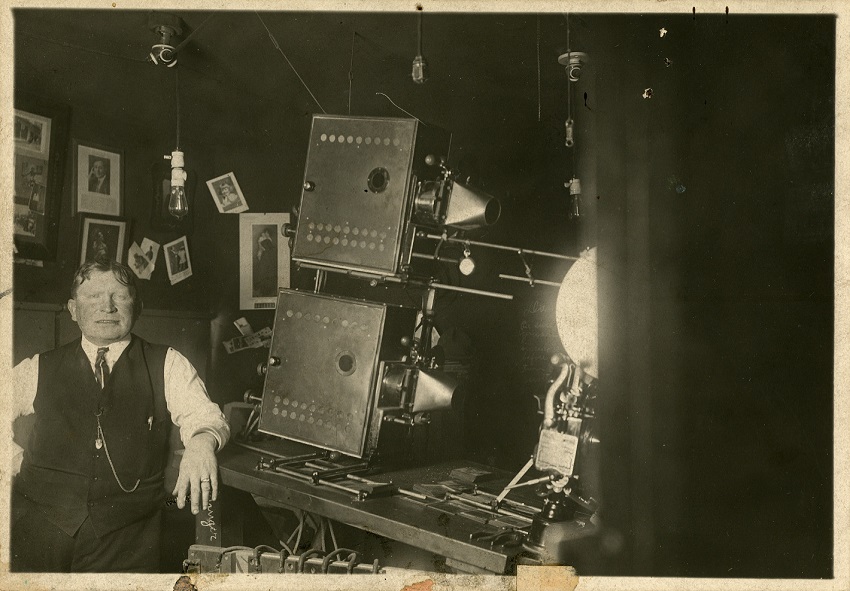
By kind permission of the Albuquerque Museum, gift of David Grammer, call number PA2004.033.005
Click here to see the full image.
See? Just like I said. That bottom lamphouse could slide back and forth
to illuminate either the extremely fragile glass slides or the brittle and highly inflammable nitrate film.
This photo was taken on the same morning that the other photo was taken.
Spot is dressed exactly the same and his hair falls in exactly the same way.
So, how do we know that this was taken in the third Crystal and not in the second Crystal?
The second Crystal was on Gold, and its entrance faced north:
There are
second-story windows on the second Crystal that face north, but those are office windows.
The booth was definitely encapsulated, with no windows opening to the outside.
Now, look at how the light falls in these two photos of Spot.
There is no way on earth that the sunlight could illuminate the booth in the SECOND Crystal in this way.
Spot is in the THIRD Crystal.
The photographer opened the heavy drape of a window to let the morning sun shine in.
The front of the third Crystal faced east, you see.
We see from the
Sanborn Map that the OP (short for OPerator’s Booth) was on the eastern wall,
on the 2nd floor, above the 1st-floor entrance.
The projectors are pointing west.
These two photos were taken on or a few days after the opening.
The booth looks lived-in, but maybe it looks lived-in not because it’s lived-in,
but because things were hastily moved in from the SECOND Crystal on Gold.
The decorationss are on the eastern wall.
They were surely carried over from the booth of the second Crystal.
My guess is that these photos were taken at about seven o’clock on a mid-October morning.
The sunbeams were not shining directly into the center of the booth,
but the light streaming in from the little window was nonetheless quite bright,
giving the unidentified photographer some nice indirect illumination.
Assuming that these two photos were taken on or just after 9 October,
we can make some determinations.
The sunrise angle was about somewhere between
110° and 113°.
The Sanborn Maps simplify matters by skewing roads exactly north-south and east-west,
though in reality the roads are all at angles.
Google Maps reveal almost exactly the true angles.
When we rotate the Sanborn’s image of the Crystal to match Google Maps,
and then when we draw in the angle of the sunrise (which will increase, of course, through midday),
we come up with the following diagram.
The Motiograph and Brenograph, naturally, would have been equidistant from the north and south walls of the booth,
and would have been hugging the west wall.
To my inexperienced eye, this all seems to be a perfect match and would explain the indirect sheen on the metal.
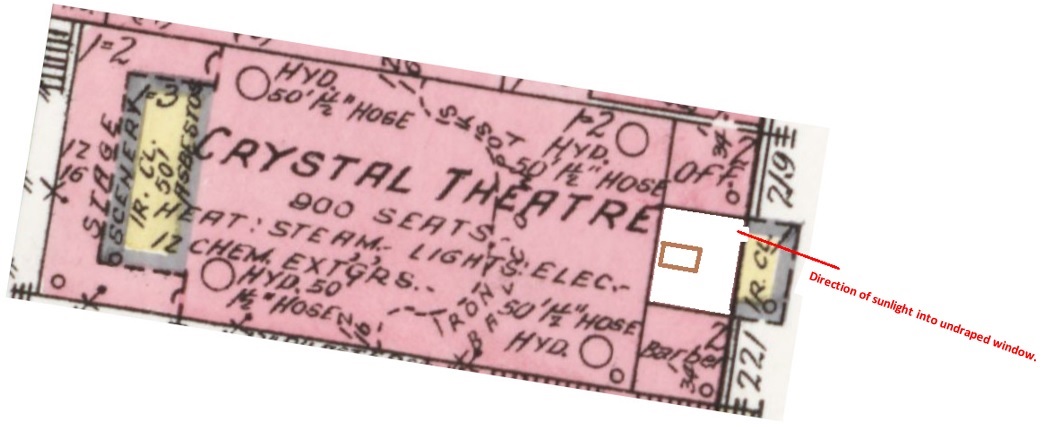
That is why I date this to 9 October 1911 or just a few days after, at about 7:00 in the morning.
So, there was poor Spot.
He never called in sick.
He never missed a show.
He had to inspect four or five or sometimes more reels each morning,
run a pair of carbon-arc lamps, feeding the rods by hand, constantly inserting new carbon rods as the old ones burned to ashes,
all day long;
he had to rewind each reel, probably by hand,
and load each new reel,
and turn the crank with one hand while he continued to feed the carbons with the other hand.
He needed only six hands, and he needed to be in only three places at once, all day long.
He had five shows a day during a ten-hour shift.
He was lucky enough to have downtime between shows.
At the end of each show, he had to brush up the piles of toxic carbon ash.
At the end of his ten-hour shift, he needed to clean the machines,
dunk the projector head in a bucket of gasoline and turn the crank a few times to expel the pasty oil sludge,
disassemble the mechanism, wipe away the remaining sludge, and then reassemble and relube it.
Further, he had to make repairs to the Motiograph 1 A that had just endured ten hours of merciless battering.
I’m sure he had an assistant who rewound the reels and ran the slides.
It would have been next to impossible for a single person to have done all that work.
A single person could have done it, yes, but the presentation would have suffered — and so would the guy’s nerves.
F.H. Richardson, “Projection Department,”
Moving Picture World, Saturday, 28 November 1914, p. 1228:
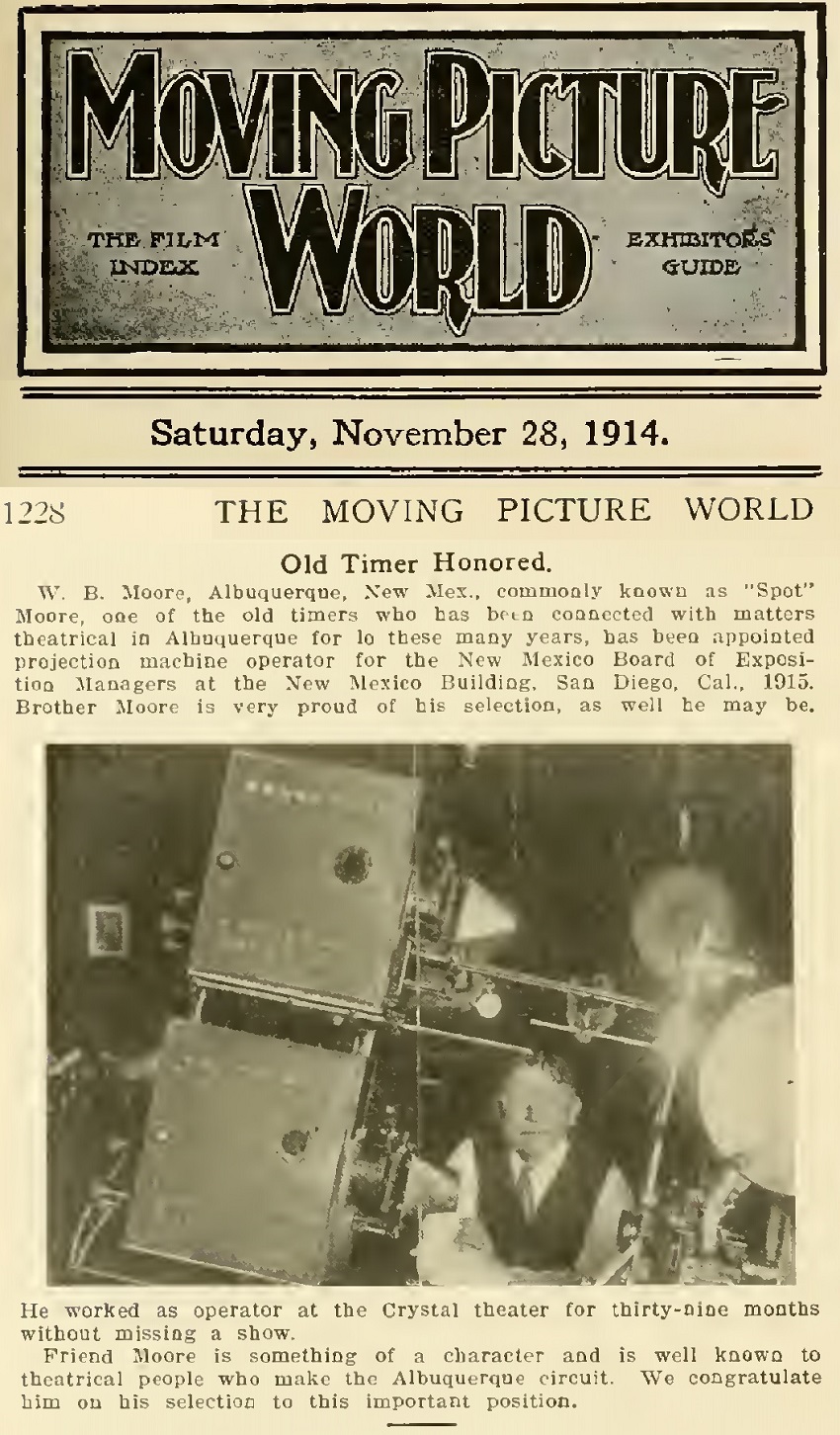
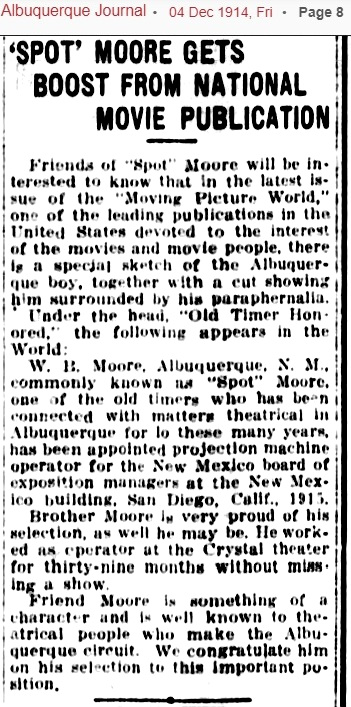
And one more. Resist can I not:
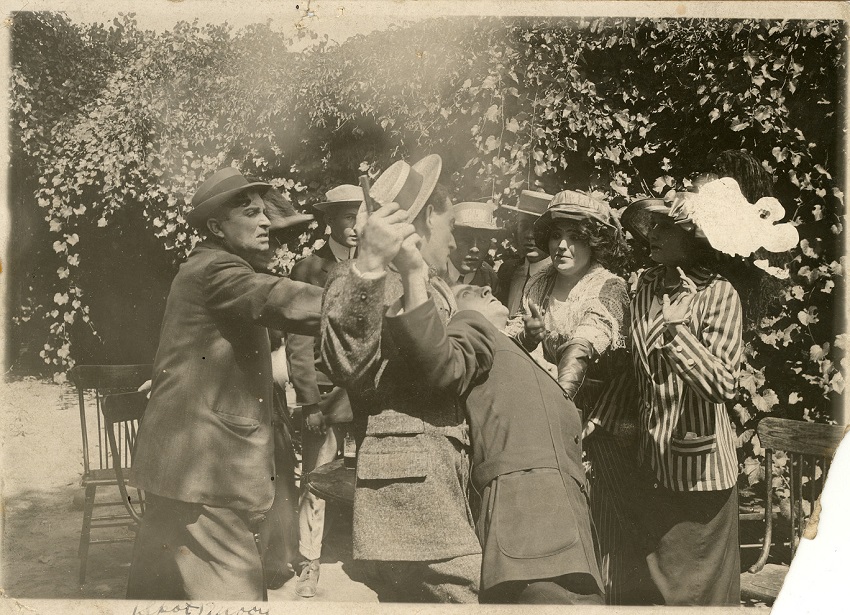
By kind permission of the Albuquerque Museum, gift of David Grammer, PA2004-033-011
Click here to enlarge.
Spot is on the left. This may have been an outdoor
of a rehearsal for some play or another.
Or, maybe maybe maybe, this was a movie shoot???
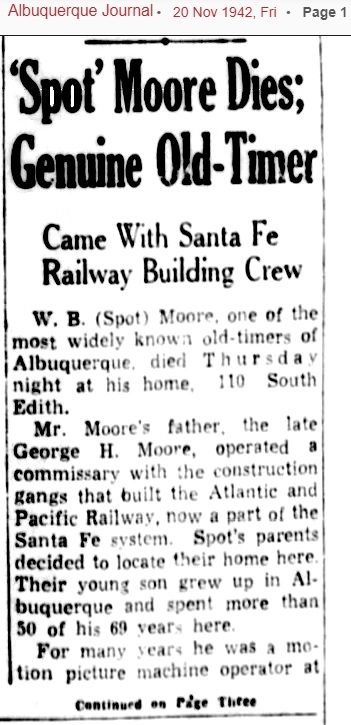
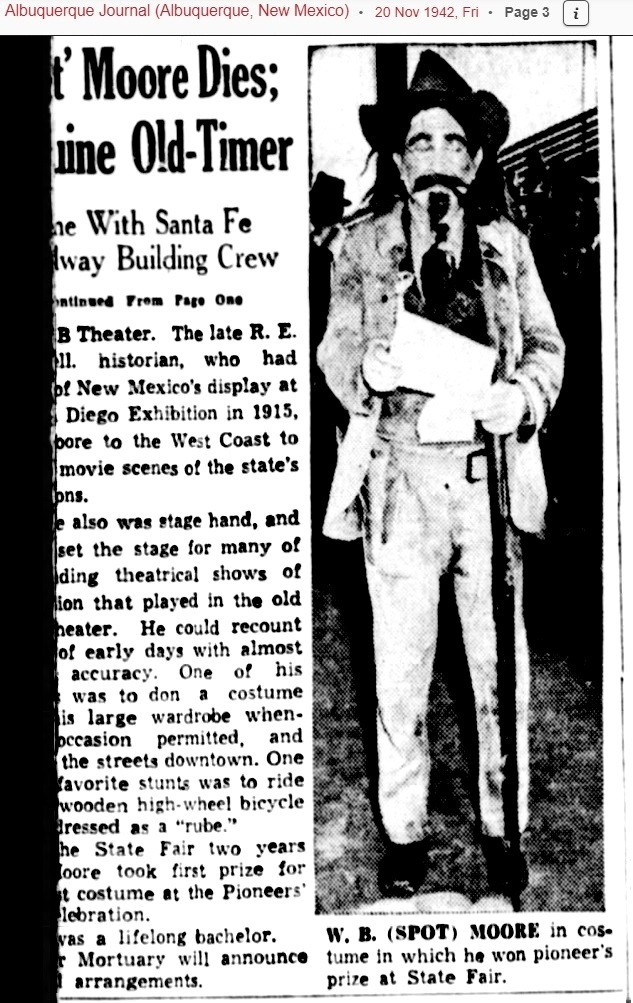
Let me try to retype that (inevitable guesswork — sorry):
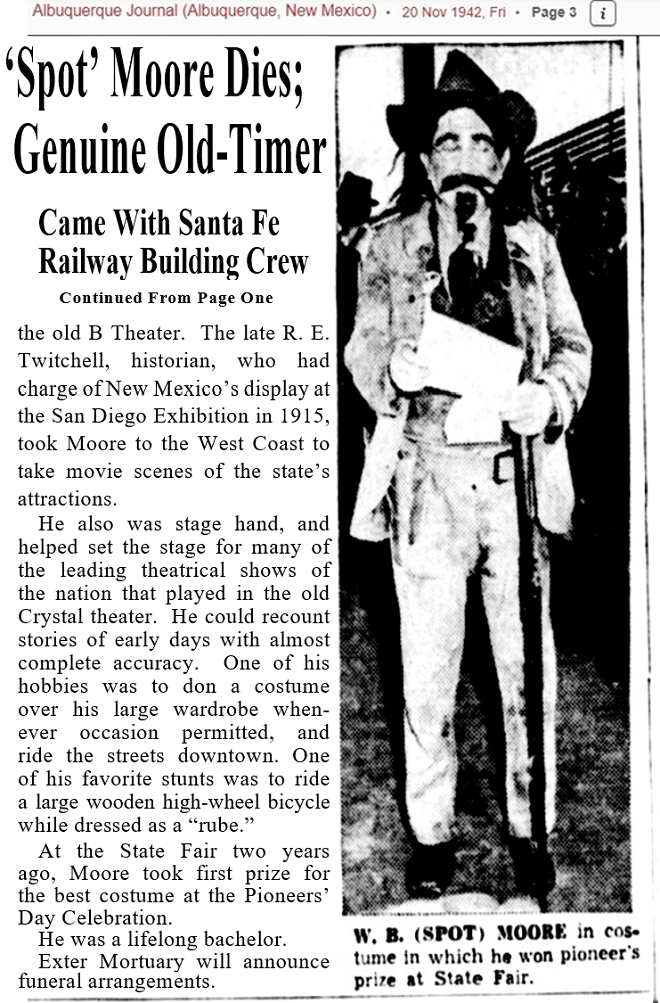
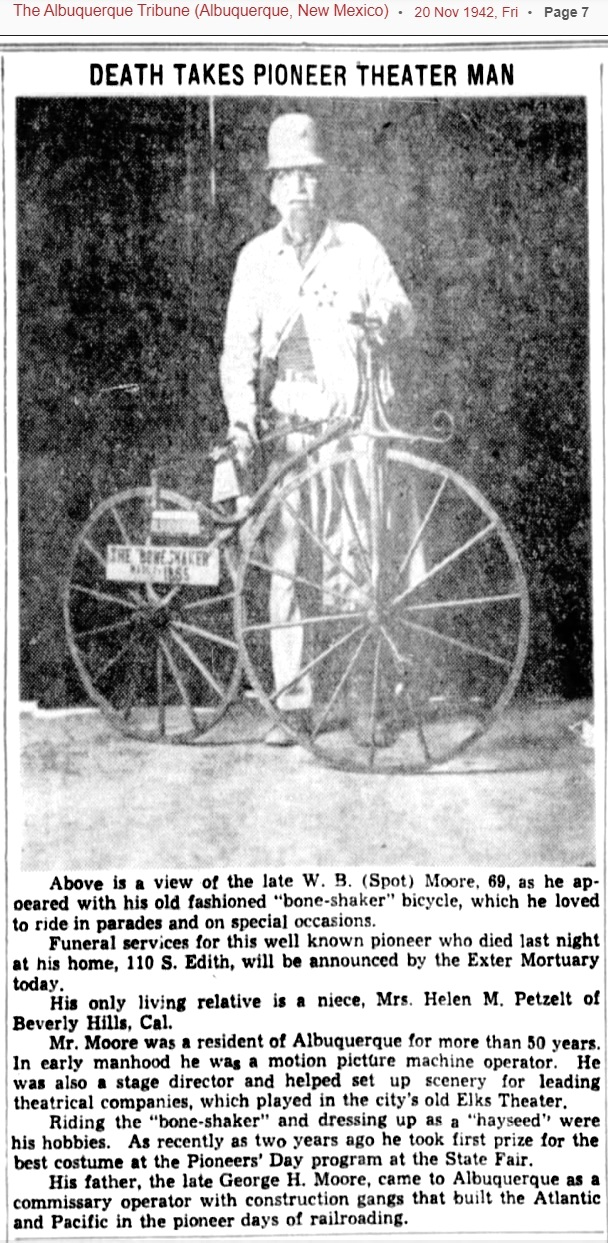
The B Theatre
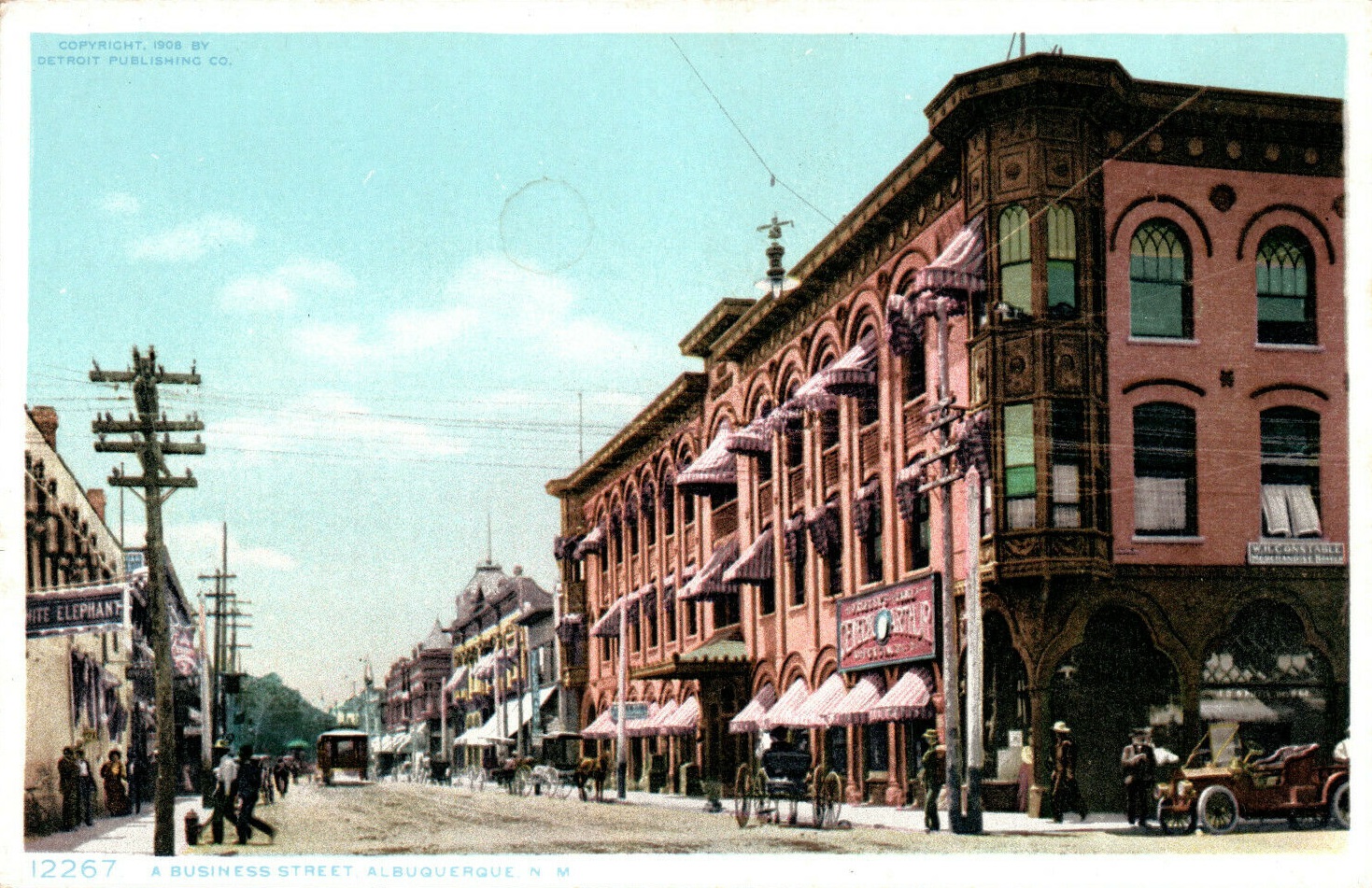
Before you get confused — and, yeah, I got really confused for a while — look at the left side of this image.
You will see a little sign protruding at a 45° angle, and it reads WHITE ELEPHANT.
Just look at it, look at it and remember where it is.
You’ll see why.
Now, look at the big building that takes up the right half of this image.
It is the Barnett Building at 202 Central Ave SW, and the camera is looking south down 2nd St.
It was was built in 1902 and here is how it looked in 1908.
As you can guess from the name, the Barnett Building was built by Barnett — yes, the same Joseph Barnett.
As you can readily discern from Mr. Barnett’s surname, he was Italian.
Look at the corner of the building.
You will see a turret on the upper stories, but an arcaded entrance on the ground floor.
Behind the arcades were entrance doors at a 45° angle.
Half-way down the building, on the 2nd St side, is another entrance.
That side entrance was gone by the beginning of 1915.
Mr. Barnett gutted the first story of his building
and had a cinema/theatre constructed inside.
He called it The B Theatre.
Hmmmmm. I wonder what B stood for.
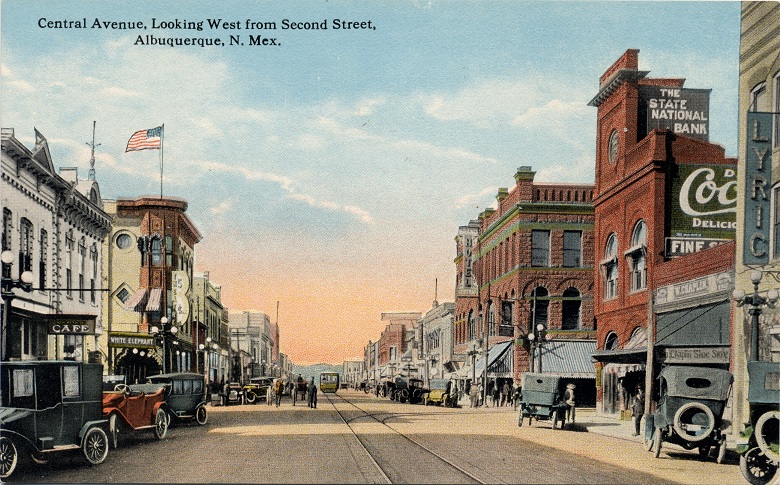
Reproduced courtesy of Historic Albuquerque, Inc., Jim Coad Collection.
Despite the caption, the camera is closer to 1st St.
2nd St. is the closest intersection.
The above is one of my favorite postcards.
This is taken from another angle, looking west up Central rather than south down 2nd.
If you know exactly where to look, though, you can see something amazing.
Here, let me enlarge a detail:
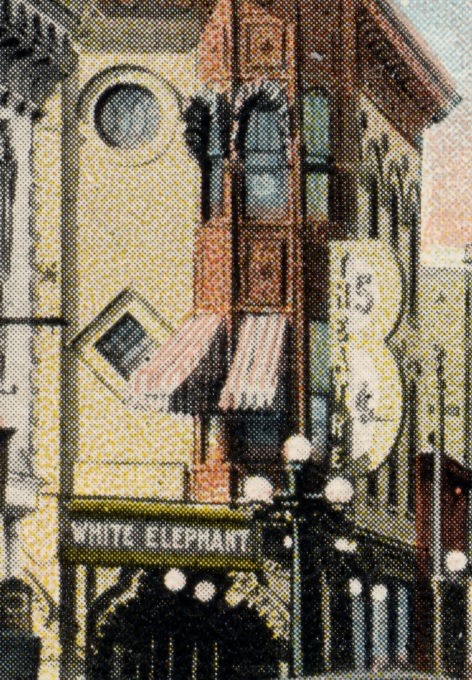
Reproduced courtesy of Historic Albuquerque, Inc., Jim Coad Collection.
Note the arcaded entrance.
Note the gigantic B.
Down the left side of the B is written
T
H
E
A
T
R
E
H
E
A
T
R
E
Directly onto the hollows of the B is written
5
¢
¢
and so that is the entrance to the B Theatre.
Now you can understand why I told you not to get confused by the sign indicating the WHITE ELEPHANT.
Scroll back up to the older postcard to look at the WHITE ELEPHANT sign again.
Charlie
Oy, you see that? I just got carried away again.
All I wanted to do was find out when Charlie’s earliest movies first played in Albuquerque.
I thought that would take me less than an hour.
Instead, it forced me to get sidetracked.
I wanted to research one tiny simple little thing, and then I fell off the edge of the earth.
Charlie’s movies, like all the other movies, arrived in town, and before the day was through, they were shipped away again.
Few were seen again until rather recently.
A bunch of the bookings were of spurious versions, mash-ups by pirates consisting of scenes of Chaplin films,
hammered together and distributed without any permissions.
Some of those horrid mash-ups were made by the studios themselves!
Bizarre.
The B Theatre certainly showed pirated films, almost certainly retitled,
which explains why it usually decided against publishing those titles.
Some of the below films are not even Chaplin movies!
One, actually, does not claim to be by Chaplin, as it is an animated cartoon,
but it was produced by his employer at the time and capitalized on his name, and so I included it.
It appears that not all the Chaplin movies reached Albuquerque until the days of VHS.
Charlie fascinates me, but not for the reasons you might think.
When I was little, I was overawed by silent comedies, which I saw excerpted on TV.
So, I got to laugh myself sick watching Harry Langdon, Buster Keaton, Charley Chase,
and a bunch of the others.
Laurel & Hardy were almost constantly on the TV as kiddie programming,
and though I never saw their silent works in my youth, I just adored those two.
Then, of course, I kept hearing about the legend, the greatest of them all,
the guy who put all the others to shame, the greatest comic who ever lived,
the funniest person in the world, a Mr. Charles Spencer Chaplin.
Oooooo. Sounded wonderful.
Then the great Charlie appeared, and we saw him, and this is what we saw:
https://youtu.be/cmyKIXMwgms.
We watched that junk in befuddlement, consternation, exasperation, and anger.
This is supposed to be great?
This guy is supposed to be funny?
Who’s having us on, and why?
This guy is useless. He’s talentless. He’s boring. He’s dull. The movie is utter TRASH.
We were all disgusted.
Nonetheless, I saw more.
I did not realize that what we were watching were bastardized copies of really rotten early movies,
before Charlie had learned the ropes and purchased his independence.
When we watch him develop, and especially when we learn that he became his own banker, his own investor, his own producer,
then, yes, I agree, he was the greatest of them all. Undoubtedly.
Not my favorite. Not a genius. Not brilliant.
He had a poor sense of story construction.
His attempts at pathos generally come across as schmaltz.
He was often but not always extremely good, occasionally totally rotten.
Sometimes he was exceeedingly funny, but his humor only works when shown to large audiences.
As a businessman, though, he was unparalleled in the movie industry.
That’s what made him the best.
When
David Shepard and Serge Bromberg released their reconstructions of the earliest Chaplin movies,
I was overwhelmed.
I had hated all those movies before, but now I loved them.
(Well, I always liked The Rounders, I mean, a lot. That was the only exception.)
There was a magic to them that was invisible in the earlier, battered, blurry, choppy copies.
The magic, though, had little to do with Charlie.
The magic was the freedom of a bunch of fairly young folks just having a goofy time while improvising meaningless nonsense.
I can only hope that fuller, more-complete editions will turn up, sooner rather than later.
Unlike the Crystal, which had set curtain times,
the Pastime and the B were grind houses, offering continuous performances.
What that means is that they would turn out the lights and start the movie running, and then open the doors.
People would mosey down the boardwalk, stop to buy tickets, walk in, let their eyes adjust to the blackness for two or three minutes,
and then make their way to the nearest empty seats.
Most movies were only one or two reels long,
and each reel ran 12 minutes, give or take.
Between reels were glass slides on screen.
As quickly as humanly possible, the next reel was on screen.
The house lights were never turned on.
The gears in the projector never stopped grinding.
The curtains never closed.
When the final movie in the program reached its end,
the first one would start all over again, right away.
If the film broke, as film was prone to do in those days — a lot! — the audience was treated to glass slides once again.
People would buy tickets, walk in, watch until they recognized a familiar scene,
“This is where we came in,” and then leave.
The full program was usually an hour or so, plus slides between reels.
The doors opened at about one o’clock in the afternoon
and when the final program concluded at about eleven o’clock at night,
the few stragglers were all kicked out and that was the end of the day’s work —
except that the unfortunate projectionist then needed to spend an hour or two repairing the machines
and replacing parts after the ten hours of nonstop beating,
sweeping up buckets of ash, washing away pasty black oil.
And except that the other staff members needed to sweep up and mop and clean, not an easy task after selling a few thousand tickets in a day.
That’s a few thousand disastrous messes to wash away and disinfect, every night and into the wee hours of the morning.
So, each short subject was shown about nine times in a day and then it was shipped out to the next cinema in some other town.
Rare was the film that was shipped in a second time.
If you really liked a movie and wanted to see it again, well, tough, you couldn’t —
unless you lived long enough to buy the VHS edition seven decades later.
The Pastime sensibly abandoned continuous shows in February 1916 and adopted announced curtain times instead.
I see that in May 1923,
The B was presenting some sort of vaudeville with its movies and had curtain times.
I don’t think it kept to that policy for too long.
The below chart is incomplete.
I’ll work on it by and by.
This chart shows us that several of Charlie’s movies returned for a second day.
Amazing.
That almost never happened with movies back in them thar days.
This Charlie guy must have been massively popular with Albuquerque audiences.
| DATE | CINEMA | Rel# | US Rel Date | TITLE |
| Tue 03 Mar 1914 | Pastime | K01 | 1914-01-15 | How Motion Pictures Are Made (This had to have been Charlie’s first movie, of which less than three frames survive.) (Albuquerque première) |
| Fri 24 Jul 1914 | Pastime | K20 | 1914-06-13 | Mabel’s Busy Day (Albuquerque première) |
| Sat 25 Jul 1914 | Pastime | K19 | 1914-06-11 | The Knockout (Albuquerque première) |
| Sat 01 Aug 1914 | Pastime | K21 | 1914-06-20 | Mabel’s Married Life (Albuquerque première) |
| Mon 28 Dec 1914 | Pastime | K35 | 1914-12-05 | Getting Acquainted (Albuquerque première) |
| Fri 01 Jan 1915 | Pastime | K34 | 1914-11-09 | His Trysting Places (Albuquerque première) |
| Fri 15 Jan 1915 | Pastime | K31 | 1914-10-26 | Charles Chaplin (must have been Dough and Dynamite) (Albuquerque première) |
| Fri 29 Jan 1915 | Pastime | K36 | 1914-12-07 | His Prehistoric Past (Albuquerque première) |
| Thu 25 Feb 1915 | Pastime | K17 | 1914-06-01 | The Fatal Mallet (Albuquerque première) |
| Sat 27 Feb 1915 | B | E01 | 1915-02-01 | His New Job (Albuquerque première) |
| Sat 13 Mar 1915 | B | E02 | 1915-02-15 | A Night Out (Albuquerque première) |
| Sat 03 Apr 1915 | B | E03 | 1915-03-11 | The Champion (Albuquerque première) |
| Fri 23 Apr 1915 | B | E04 | 1915-03-18 | In the Park (Albuquerque première) |
| Wed 28 Apr 1915 | B | E05 | 1915-04-01 | A Jitney Elopement (Albuquerque première) |
| Tue 11 May 1915 | Pastime | K31 | 1914-10-26 | Dough and Dynamite (repeat from 15 Jan 1915) |
| Wed 12 May 1915 | B | E06 | 1915-04-11 | The Tramp (Albuquerque première) |
| Sat 15 May 1915 | Pastime | K25 | 1914-08-13 | Recreation (Albuquerque première) |
| Tue 18 May 1915 | Pastime | K19 | 1914-06-11 | The Knockout (repeat from 25 Jul 1914) |
| Sat 22 May 1915 | Pastime | K33 | 1914-11-07 | His Musical Career (Albuquerque première) |
| Sat 22 May 1915 | B | – | – |
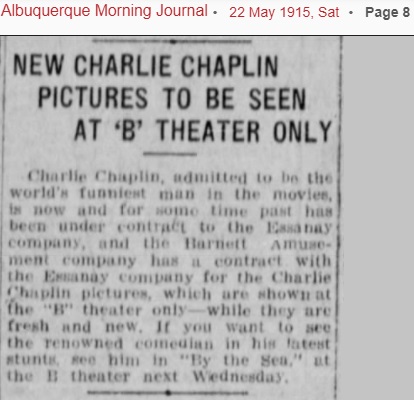 |
| Tue 25 May 1915 | Pastime | K23 | 1914-08-01 | The Property Man (Albuquerque première) |
| Wed 26 May 1915 | B | E07 | 1915-04-29 | By the Sea (Albuquerque première) |
| Fri 28 May 1915 | Crystal | K37 | 1914-12-14 | Tillie’s Punctured Romance (Albuquerque première) |
| Sat 29 May 1915 | ||||
| Sat 29 May 1915 | Pastime | K26 | 1914-08-27 | The Masqueraders [sic] (Albuquerque première) |
| Sat 05 Jun 1915 | Pastime | K30 | 1914-10-10 | Those Love Pangs (Albuquerque première) |
| Sat 12 Jun 1915 | Pastime | K35 | 1914-12-05 | Getting Acquainted (repeat from 28 Dec 1914) |
| Sat 19 Jun 1915 | Pastime | K29 | 1914-09-24 | The New Janitor (Albuquerque première) |
| Sat 26 Jun 1915 | Pastime | K?? | 1914-??-?? | |
| Sat 03 Jul 1915 | Pastime | K08 | 1914-03-26 | Cruel, Cruel Love (Albuquerque première) |
| Sat 03 Jul 1915 | B | E09 | 1915-06-21 | Work (Albuquerque première) |
| Tue 20 Jul 1915 | Pastime | K34 | 1914-11-09 | His Trysting Place [sic] (repeat from 01 Jan 1915) |
| Sat 07 Aug 1915 | Pastime | K36 | 1914-12-07 | His Prehistoric Past (repeat from 29 Jan 1915) |
| Tue 10 Aug 1915 | Pastime | K12 | 1914-04-18 | Mabel at the Wheel (Albuquerque première) |
| Wed 11 Aug 1915 | B | E10 | 1915-07-12 | A Woman (Albuquerque première) |
| Sat 14 Aug 1915 | Pastime | K28 | 1914-09-07 | The Rounders (Albuquerque première) |
| Tue 17 Aug 1915 | Pastime | K04 | 1914-02-09 | Mabel’s Strange Predicament (Albuquerque première) |
| Wed 18 Aug 1915 | Pastime | K37 | 1914-12-14 | Tillie’s Punctured Romance (premièred at the Crystal 28–29 May 1915) |
| Tue 31 Aug 1915 | Pastime | K15 | 1914-05-04 | Caught in the Rain (Albuquerque première) |
| Mon 06 Sep 1915 | B | – | 1915-08-15 | Dreamy Dud Sees Charlie Chaplin (Wallace A. Carlson cartoon, Essanay production, and now lost) |
| Tue 07 Sep 1915 | Pastime | K07 | 1914-03-02 | [A] Film Johnnie (Albuquerque première) |
| Sat 11 Sep 1915 | Pastime | K24 | 1914-08-10 | [The] Face on the Bar Room Floor (Albuquerque première) |
| Wed 15 Sep 1915 | B | E11 | 1915-08-09 | The Bank (Albuquerque première) |
| Sat 18 Sep 1915 | Pastime | K14 | 1914-04-27 | Caught in a Cabaret (Albuquerque première) |
| Sat 25 Sep 1915 | Pastime | K22 | 1914-07-09 | Laughing Gas (Albuquerque première) |
| Sat 02 Oct 1915 | Pastime | K11 | 1914-04-04 | The Star Boarder (Albuquerque première) |
| Thu 07 Oct 1915 | Pastime | – | 1915-08-15 | The Mix-Up
(Excerpts of Chaplin clips from his Keystone films, mashed together into a new feature; producer and distributor unknown)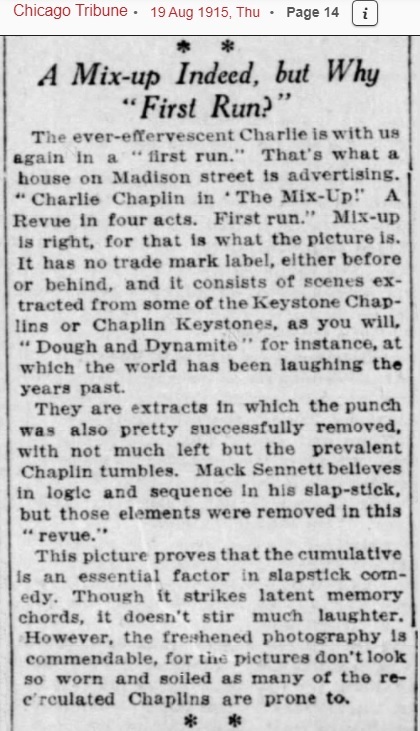 Note what this article says. Well prior to August 1915, the Chaplin Keystones were already battered! This unauthorized and anonymous anthology, hammered together by humorless editors, was derived from superior sources! I would love to find a copy of this lost film. |
| Sat 09 Oct 1915 | Pastime | K11 | 1914-04-04 | |
| Tue 19 Oct 1915 | B | E12 | 1915-10-04 | Shanghaied (Albuquerque première) |
| Sat 23 Oct 1915 | Pastime | K20 | 1914-06-13 | Mabel’s Busy Day (repeat from 24 Jul 1914) |
| Sat 30 Oct 1915 | Pastime | K15 | 1914-05-04 | |
| Sat 30 Oct 1915 | Pastime | K05 | 1914-02-28 | Between Showers (repeat) [previous showing was not advertised] |
| Sat 06 Nov 1915 | Pastime | K27 | 1914-08-31 | His New Profession (repeat) [previous showing was not advertised] |
| Tue 30 Nov 1915 | B | E13 | 1915-11-20 | A Night in the Show (Albuquerque première) (This terminated the B/Essanay/Chaplin contract) |
| There were several days when the Pastime did not advertise.
Also, the advertisements were not always reliable.
As far as I can determine, the following Keyston/Chaplin films did not play in Albuquerque when they were new,
though some of them did finally show up at UNM in the 1950’s: • Making a Living (K02, 1914-02-02) • Kid Auto Races at Venice, Ca. (K03, 1914-02-07) • The Thief Catcher (K05, 1914-02-19) • Tango Tangles (K08, 1914-03-09) • His Favorite Pastime (K09, 1914-03-16) • Twenty Minutes of Love (K13, 1914-04-20; this was shown in Jun 1919 under a different title) • A Busy Day (K16, 1914-05-07) • Her Friend the Bandit (K18, 1914-06-04) • Gentlemen of Nerve (K32, 1914-10-29) Also, for whatever it’s worth, I cannot find an announcement for His Regeneration, an Essanay film with a Chaplin |
||||
| Sat 25 Mar 1916 | Crystal | – | – | Le Roy Osborne presents The Chicklets in the Chaplin and Ritchie Comedy, A Day at the Circus (This was a touring vaudeville act, seemingly with Chaplin and Ritchie impersonators) |
| Sun 26 Mar 1916 | Crystal | – | – | Charley Chaplin and Billie Ritchie in The Mashers (This was a touring vaudeville act, seemingly with Chaplin and Ritchie impersonators) |
| Sun 07 May 1916 | Crystal | E16 | 1916-04-10 | Burlesque on Carmen (Albuquerque première) (Essanay padded Chaplin’s Carmen with outtakes and new material; Charlie was so upset that he took ill for several days. The good news is that this trauma convinced him to have total contractual control, and soon afterwards total ownership, of all his future films.) |
| Mon 08 May 1916 | ||||
| Sun 04 Jun 1916 | Pastime | M01 | 1916-05-15 | The Floorwalker (Albuquerque première) |
| Mon 05 Jun 1916 | ||||
| Sun 02 Jul 1916 | Pastime | M02 | 1916-06-12 | The Fireman (Albuquerque première) |
| Mon 03 Jul 1916 | ||||
| Sat 08 Jul 1916 | Crystal | E15 | 1915-03-27 | Police (Albuquerque première) |
| Sun 09 Jul 1916 | ||||
| Tue 25 Jul 1916 | B | – | – | Charlie Chaplin in a Two-reel Comedy Reissue (probably a Keystone) |
| Sun 30 Jul 1916 | B | – | – | Charley Chaplin (probably a Keystone) |
| Sun 30 Jul 1916 | Pastime | M03 | 1916-07-10 | The Vagabond (Albuquerque première) |
| Mon 31 Jul 1916 | ||||
| Tue 01 Aug 1916 | B | – | – | A 3-Reel Charlie Chaplin, Charlie’s First Vacation (a counterfeit; surely mashed together from clips; appears to be lost) |
| Tue 08 Aug 1916 | B | – | – | A Charley Chaplin Two-Reel Laugh Maker Extra (probably a Keystone) |
| Sat 19 Aug 1916 | B | – | – | Charles Chaplin in a Two-part Comedy Reissue (probably a Keystone) |
| Sun 27 Aug 1916 | B | – | – | Charles Chaplin in a Two-part Reissue Comedy (probably a Keystone) |
| Sun 27 Aug 1916 | Pastime | M04 | 1916-08-07 | One A.M. (Albuquerque première) |
| Mon 28 Aug 1916 | ||||
| Sun 24 Sep 1916 | Pastime | M06 | 1916-09-04 | The Count (Albuquerque première) |
| Mon 25 Sep 1916 | ||||
| Tue 03 Oct 1916 | B | – | – | Charles Chaplin in Charley’s Stormy Romance, four reels of mirth (a counterfeit; surely mashed together from clips; appears to be lost) |
| Sun 22 Oct 1916 | Pastime | M05 | 1916-10-02 | The Pawn Shop (Albuquerque première) |
| Mon 23 Oct 1916 | ||||
| Sun 03 Dec 1916 | Pastime | M07 | 1916-11-13 | Behind the Screen (Albuquerque première) |
| Mon 04 Dec 1916 | ||||
| Thu 28 Dec 1916 | B | – | – | Charley Chaplin in a Two-Part Comedy (probably a Keystone) |
| Sun 31 Dec 1916 | Pastime | M08 | 1916-12-04 | The Rink (Albuquerque première) |
| Mon 01 Jan 1917 | ||||
| Thu 04 Jan 1917 | B | – | – | Charlie Chaplin in a Two Reel Comedy (probably a Keystone) |
| Thu 11 Jan 1917 | B | – | – | Charlie Chaplin in a Two Reel Comedy (probably a Keystone) |
| Thu 18 Jan 1917 | B | – | – | Charlie Chaplin a Two Reel Comedy (probably a Keystone) |
| Thu 25 Jan 1917 | B | – | – | Charlie Chaplin in a Two Reel Comedy (probably a Keystone) |
| Thu 01 Feb 1917 | B | – | – | A 2-Part Charley Chaplin (probably a Keystone) |
| Mon 12 Feb 1917 | B | – | – | Charley Chaplin (probably a Keystone) |
| Wed 14 Feb 1917 | Lyric | E17 | 1916-09-23 | The Essanay-Chaplin Revue of 1916 (Essanay weaved together His New Job, A Night Out, and The Tramp into a single story and filmed new linking material with a Chaplin impersonater named Graham Douglas; this film is now lost) |
| Thu 22 Feb 1917 | B | – | – | Charley Chaplin in The Nightmare (a counterfeit; surely a mash-up of clips; seems to be lost) |
| Sun 25 Feb 1917 | Pastime | M09 | 1917-01-22 | Easy Street (Albuquerque première) |
| Mon 26 Feb 1917 | ||||
| Thu 08 Mar 1917 | B | – | – | Charley Chaplin in a two-part comedy (probably a Keystone) |
| Thu 22 Mar 1917 | B | – | – | Charles Chaplin in a two-part comedy (probably a Keystone) |
| Thu 19 Apr 1917 | B | – | – | Charley Chaplin in a two-reel comedy (probably a Keystone) |
| Sun 06 May 1917 | Pastime | M10 | 1917-04-16 | |
| Mon 07 May 1917 | Pastime | M10 | 1917-04-16 | The Cure (Albuquerque première) |
| Fri 18 May 1917 | B | – | – | Charley Chaplin [CANCELED?] |
| Sat 26 May 1917 | Pastime | M10 | 1917-04-16 | The Cure repeating at request |
| Tue 05 Jun 1917 | B | – | – | Charley Chaplin in a two-reel comedy (probably a Keystone) |
| Sun 08 Jul 1917 | Pastime | M11 | 1917-06-17 | The Immigrant (Albuquerque première) |
| Mon 09 Jul 1917 | ||||
| Sat 14 Jul 1917 | Crystal | – | – | Charlie Chaplin in The Mirth of a Nation
Two Big Reels of Laughter
(a counterfeit, a |
| Sun 15 Jul 1917 | ||||
| Sat 21 Jul 1917 | Crystal | – | – | Charlie Chaplin in A Son of the Gods Two Parts (a counterfeit) |
| Sun 22 Jul 1917 | ||||
| Sat 24 Nov 1917 | B | E03 | 1915-03-11 | The Champion (Albuquerque première) |
| Mon 03 Dec 1917 | Pastime | M12 | 1917-10-22 | The Adventurer (Albuquerque première) |
| Tue 25 Dec 1917 | Crystal | – | – | A Charley Chaplin two-reel comedy (probably a Keystone) |
| Fri 14 Jun 1918 | Lyric | F01 | 1918-04-14 | A Dog’s Life (Albuquerque première) |
| Sat 15 Jun 1918 | ||||
| Sat 06 Apr 1918 | Crystal | E01 | 1915-02-01 | His New Job |
| Sun 07 Apr 1918 | ||||
| Wed 07 Aug 1918 | B Theater | – | – | Chase Me, Charlie (1918, mashup of clips from Essanay films) |
| Tue 17 Sep 1918 | Pastime | K23 | 1914-08-01 | The Roustabout (reissue of The Property Man) |
| Wed 18 Sep 1918 | ||||
| Mon 09 Dec 1918 | Ideal | K37 | 1914-12-14 | Tillie’s Punctured Romance (revival) |
| Tue 10 Dec 1918 | ||||
| Fri 20 Dec 1918 | Lyric | F02 | 1918-10-20 | Shoulder Arms (Albuquerque première) |
| Sat 21 Dec 1918 | ||||
| Sun 22 Dec 1918 | ||||
| Mon 03 Feb 1919 | Ideal | K23 | 1914-08-01 | The Roustabout (reissue of The Property Man) |
| Sun 16 Mar 1919 | Pastime | K28 | 1914-09-07 | Who Got Stung? (reissue of The Rounders) |
| Mon 17 Mar 1919 | ||||
| Sun 19 Apr 1919 | Pastime | E11 | 1915-08-09 | The Bank (repeat) |
| Mon 20 Apr 1919 | ||||
| Fri 20 Jun 1919 | Pastime | K13 | 1914-04-20 | The Love Friend (reissue of Twenty Minutes of Love) |
| Sat 21 Jun 1919 | ||||
| Tue 07 Oct 1919 | Pastime | K24 | 1914-08-10 | Ham Artists (reissue of The Face on the Bar Room Floor) |
| Thu 07 Aug 1919 | Lyric | F03 | 1919-06-15 | Sunnyside (Albuquerque première) |
| Fri 08 Aug 1918 | ||||
| Sat 09 Aug 1918 | ||||
| Fri 09 Jan 1920 | Lyric | F04 | 1919-12-07 | A Day’s Pleasure (Albuquerque première) |
| Sat 10 Jan 1920 | ||||
| Sun 22 May 1921 | Lyric | F05 | 1921-02-06 | The Kid (Albuquerque première) |
| Mon 23 May 1921 | ||||
| Tue 24 May 1921 | ||||
| Wed 25 May 1921 | ||||
| Thu 26 May 1921 | ||||
| Fri 27 May 1921 | ||||
| Sat 28 May 1921 | ||||
| Sun 29 Jan 1922 | B | F06 | 1921-09-25 | The Idle Class (Albuquerque première) |
| Mon 30 Jan 1922 | ||||
| Sun 27 Aug 1922 | B | F07 | 1922-04-02 | Pay Day (Albuquerque première) |
| Mon 28 Aug 1922 | ||||
| Sun 28 Oct 1923 | B | F08 | 1923-02-25 | The Pilgrim (Albuquerque première) |
| Mon 29 Oct 1923 | ||||
| Tue 30 Oct 1923 | ||||
| Wed 31 Oct 1923 | ||||
| Thu 01 Nov 1923 | ||||
| Tue 12 Feb 1924 | Pastime | U01 | 1923-10-01 | A Woman of Paris (Albuquerque première) |
| Wed 13 Feb 1924 | ||||
| Thu 14 Feb 1924 | ||||
| Fri 15 Feb 1924 | ||||
| Sat 16 Feb 1924 | ||||
| Sun 25 Oct 1925 | Sunshine | U02 | 1925-06-25 | The Gold Rush (Albuquerque première) |
| Mon 26 Oct 1925 | ||||
| Tue 27 Oct 1925 | ||||
| Wed 28 Oct 1925 | ||||
| Thu 29 Oct 1925 | ||||
| Wed 11 Apr 1928 | KiMo | U03 | 1928-01-07 | The Circus (Albuquerque première) |
| Thu 12 Apr 1928 | ||||
| Fri 13 Apr 1928 | ||||
| Sat 14 Apr 1928 | ||||
| Sun 17 May 1931 | KiMo | U04 | 1931-01-30 | City Lights (Albuquerque première) |
| Mon 18 May 1931 | ||||
| Tue 19 May 1931 | ||||
| Wed 20 May 1931 | ||||
| Sat 25 Apr 1936 | KiMo | U05 | 1936-02-05 | Modern Times (Albuquerque première) |
| Sun 26 Apr 1936 | ||||
| Mon 27 Apr 1936 | ||||
| Tue 28 Apr 1936 | ||||
| Tue 21 Jan 1941 | UNM Rodey | K37 | 1914-12-14 | Tillie’s Punctured Romance (MoMA, 16mm) |
| Fri 27 Feb 1942 | KiMo | U06 | 1940-10-15 | The Great Dictator (Albuquerque première) |
| Sat 28 Feb 1942 | ||||
| Sun 01 Mar 1942 | ||||
| Mon 02 Mar 1942 | ||||
| Tue 03 Mar 1942 | ||||
| Wed 04 Mar 1942 | ||||
| Fri 26 Jul 1942 | Sunshine | U07 | 1942-05-19 | The Gold Rush (with music and words) (Albuquerque première) |
| Sat 27 Jul 1942 | ||||
| Sun 28 Jul 1942 | ||||
| Mon 29 Jul 1942 | ||||
| Sat 09 Jan 1943 | Lobo | U07 | 1942-05-19 | The Gold Rush (with music and words) |
| Thu 11 Feb 1943 | Mesa | U07 | 1942-05-19 | The Gold Rush (with music and words) |
| Fri 12 Feb 1943 | ||||
| Sat 01 Jan 1950 | UNM |
M08 | 1916-12-04 | The Rink (MoMA, 16mm) |
| M03 | 1916-07-10 | The Vagabond (MoMA, 16mm) | ||
| M09 | 1917-01-22 | Easy Street (MoMA, 16mm) | ||
| K34 | 1914-11-09 | His Trysting Places (MoMA, 16mm) | ||
| Sat 17 Feb 1951 | UNM Rodey | E16 | 1916-04-10 | Burlesque on Carmen (and other unspecified shorts, MoMA 16mm) |
| Sat 23 Feb 1952 | UNM Rodey | M12 | 1917-10-22 | The Adventurer (MoMA, 16mm) |
| K27 | 1914-08-31 | His New Profession (MoMA, 16mm) | ||
| K02 | 1914-02-02 | Making a Living (Albuquerque première, 16mm, MoMA) | ||
| M07 | 1916-11-13 | Behind the Screen (MoMA, 16mm) | ||
| K35 | 1914-12-05 | Getting Acquainted (MoMA, 16mm) | ||
| K19 | 1914-06-11 | The Knockout (MoMA, 16mm) | ||
| K28 | 1914-09-07 | The Rounders (MoMA, 16mm) | ||
| Sat 13 Dec 1952 | UNM Mitchell | M06 | 1916-09-04 | The Count (MoMA, 16mm) |
| M04 | 1916-08-07 | One A.M. (MoMA, 16mm) | ||
| M07 | 1916-11-13 | Behind the Screen (MoMA, 16mm) | ||
| M11 | 1917-06-17 | The Immigrant (MoMA, 16mm) | ||
| M09 | 1917-01-22 | Easy Street (MoMA, 16mm) | ||
| M01 | 1916-05-15 | The Floorwalker (MoMA, 16mm) | ||
| Fri 08 May 1953 | Lobo | U09 | 1952-10-23 | Limelight (Albuquerque première) |
| Sat 09 May 1953 | ||||
| Sun 10 May 1953 | ||||
| Mon 11 May 1953 | ||||
| Tue 12 May 1953 | ||||
| Wed 13 May 1953 | ||||
| Thu 14 May 1953 | ||||
| Sat 10 Dec 1955 | UNM Mitchell | M01 | 1916-05-15 | The Floorwalker (MoMA, 16mm) |
| M05 | 1916-10-02 | The Pawn Shop (MoMA, 16mm) | ||
| M10 | 1917-04-16 | The Cure (MoMA, 16mm) | ||
| M11 | 1917-06-17 | The Immigrant (MoMA, 16mm) | ||
| Sat 01 Dec 1956 | UNM Mitchell | M04 | 1916-08-07 | One A.M. (MoMA, 16mm) |
| M02 | 1916-06-12 | The Fireman (MoMA, 16mm) | ||
| M06 | 1916-09-04 | The Count (MoMA, 16mm) | ||
| M12 | 1917-10-22 | The Adventurer (MoMA, 16mm) | ||
| Sat 16 Nov 1957 | UNM Mitchell | K37 | 1914-12-14 | Tillie’s Punctured Romance (MoMA, 16mm) |
| Sat 06 Dec 1958 | UNM Mitchell | – | – | [TITLES NOT ANNOUNCED] (16mm) |
| Thu 09 Jul 1959 | Lobo | U07 | 1942-05-19 | The Gold Rush (with music and words, reissue) |
| Fri 10 Jul 1959 | ||||
| Sat 11 Jul 1959 | ||||
| Sun 12 Jul 1959 | ||||
| Mon 13 Jul 1959 | ||||
| Tue 14 Jul 1959 | ||||
| Wed 15 Jul 1959 | ||||
| Sat 26 Mar 1960 | UNM SUB | E16 | 1916-04-10 | Burlesque on Carmen (16mm) |
| Sat 08 Apr 1961 | UNM SUB | K37 | 1914-12-14 | Tillie’s Punctured Romance (16mm) |
| M05 | 1916-10-02 | The Pawn Shop (16mm) | ||
| M11 | 1917-06-17 | The Immigrant (16mm) | ||
| Thu 25 May 1961 | Lobo | K37 | 1914-12-14 | Tillie’s Punctured Romance CROPPED |
| Fri 26 May 1961 | ||||
| Sat 27 May 1961 | ||||
| Sun 28 May 1961 | ||||
| Mon 29 May 1961 | ||||
| Tue 30 May 1961 | ||||
| Wed 31 May 1961 | ||||
| Thu 07 Sep 1961 | Don Pancho’s | E04 | 1915-03-18 | In the Park (reissue) CROPPED |
| Fri 08 Sep 1961 | ||||
| Sat 09 Sep 1961 | ||||
| Sun 10 Sep 1961 | ||||
| Mon 11 Sep 1961 | ||||
| Tue 12 Sep 1961 | ||||
| Wed 13 Sep 1961 | ||||
| Thu 07 Jun 1962 | Don Pancho’s | JBr | 1952-12-10? | A Night with Charlie Chaplin (reissue of Dough and Dynamite, His Trysting Places, Caught in a Cabaret, and His Prehistoric Past) CROPPED |
| Fri 08 Jun 1962 | ||||
| Sat 09 Jun 1962 | ||||
| Sun 10 Jun 1962 | ||||
| Mon 11 Jun 1962 | ||||
| Fri 13 Mar 1964 | UNM SUB | JBr | 1952-12-10? | A Night with Charlie Chaplin (16mm, reissue of Dough and Dynamite, His Trysting Places, Caught in a Cabaret, and His Prehistoric Past) |
| Tue 06 Apr 1965 | UNM Ballroom | – | – | [TITLES NOT ANNOUNCED] (16mm) |
| Sat 19 Nov 1966 | UNM Ballroom | U02 | 1925-06-25 | The Gold Rush (16mm, piano accompaniment) |
| Wed 26 Apr 1967 | Cinema East | C01 | 1967-01-05 | A Countess from Hong Kong (Albuquerque première) |
| Thu 27 Apr 1967 | ||||
| Fri 28 Apr 1967 | ||||
| Sat 29 Apr 1967 | ||||
| Sun 30 Apr 1967 | ||||
| Mon 01 May 1967 | ||||
| Tue 02 May 1967 | ||||
| Mon 29 Dec 1969 | 1st Methodist | MoMA | [UNK] | The Gold Rush (MoMA 16mm edition; Eddie Horton, organist) |
| Thu 09 Apr 1970 | UNM SUB | U02 | 1925-06-25 | The Gold Rush (16mm, MoMA) |
| Tue 21 Apr 1970 | Civic Aud | MoMA | [UNK] | The Gold Rush (MoMA 16mm edition; Eddie Horton, organist) |
| Fri 02 Oct 1970 | UNM SUB | – | – | [TITLES NOT ANNOUNCED] (16mm) |
| Fri 12 Feb 1971 | Guild | KS | 1971-07-06 | The Gold Rush (Paul Killiam edition) CROPPED |
| Sat 13 Feb 1971 | ||||
| Sun 14 Feb 1971 | ||||
| Mon 15 Feb 1971 | ||||
| Tue 16 Feb 1971 | ||||
| Wed 17 Feb 1971 | ||||
| Thu 18 Feb 1971 | ||||
| Sat 22 Jan 1972 | Guild | U03 | 1928-01-07 | The Circus (reissue, Columbia) CROPPED |
| Sun 23 Jan 1972 | ||||
| Mon 24 Jan 1972 | ||||
| Fri 04 Feb 1972 | Don Pancho’s | U05 | 1936-02-05 | Modern Times (reissue, Columbia) CROPPED |
| Sat 05 Feb 1972 | ||||
| Sun 06 Feb 1972 | ||||
| Mon 07 Feb 1972 | ||||
| Tue 08 Feb 1972 | ||||
| Wed 09 Feb 1972 | ||||
| Thu 10 Feb 1972 | ||||
| Fri 11 Feb 1972 | ||||
| Sat 12 Feb 1972 | ||||
| Sun 13 Feb 1972 | ||||
| Mon 14 Feb 1972 | ||||
| Tue 15 Feb 1972 | ||||
| Wed 16 Feb 1972 | ||||
| Thu 17 Feb 1972 | ||||
| Fri 18 Feb 1972 | Don Pancho’s | U04 | 1931-01-30 | City Lights (reissue, Columbia) CROPPED |
| Sat 19 Feb 1972 | ||||
| Sun 20 Feb 1972 | ||||
| Mon 21 Feb 1972 | ||||
| Tue 22 Feb 1972 | ||||
| Wed 23 Feb 1972 | ||||
| Thu 24 Feb 1972 | ||||
| Fri 25 Feb 1972 | ||||
| Sat 26 Feb 1972 | ||||
| Sat 19 Feb 1972 | ||||
| Sat 19 Feb 1972 | ||||
| Sun 27 Feb 1972 | ||||
| Mon 28 Feb 1972 | ||||
| Tue 29 Feb 1972 | ||||
| Wed 01 Mar 1972 | ||||
| Thu 02 Mar 1972 | ||||
| Fri 03 Mar 1972 | Don Pancho’s | U06 | 1940-10-15 | The Great Dictator (reissue, Columbia) CROPPED |
| Sat 04 Mar 1972 | ||||
| Sun 05 Mar 1972 | ||||
| Mon 06 Mar 1972 | ||||
| Tue 07 Mar 1972 | ||||
| Wed 08 Mar 1972 | ||||
| Thu 09 Mar 1972 | ||||
| Fri 10 Mar 1972 | ||||
| Sat 11 Mar 1972 | ||||
| Sun 12 Mar 1972 | ||||
| Mon 13 Mar 1972 | ||||
| Tue 14 Mar 1972 | ||||
| Wed 15 Mar 1972 | ||||
| Thu 16 Mar 1972 | ||||
| Fri 28 Jul 1972 | Guild | U03 | 1928-01-07 | The Circus (repertory, Columbia, midnight) CROPPED |
| Sat 29 Jul 1972 | ||||
| Fri 01 Sep 1972 | UNM SUB | – | – | [TITLES NOT ANNOUNCED] (16mm) |
| Sat 02 Sep 1972 | ||||
| Wed 20 Sep 1972 | Guild | U03 | 1928-01-07 | The Circus (repertory, Columbia) CROPPED |
| Thu 21 Sep 1972 | ||||
| Fri 22 Sep 1972 | ||||
| Sat 23 Sep 1972 | ||||
| Sun 24 Sep 1972 | ||||
| Mon 25 Sep 1972 | ||||
| Tue 26 Sep 1972 | ||||
| Wed 14 Feb 1973 | UNM SUB | – | – | [TITLES NOT ANNOUNCED] (16mm) |
| Fri 16 Feb 1973 | Hiland | U05 | 1936-02-05 | Modern Times (repertory, Classic Festival?) CROPPED |
| Sat 17 Feb 1973 | ||||
| Sun 18 Feb 1973 | ||||
| Fri 02 Mar 1973 | Hiland | U06 | 1940-10-15 | The Great Dictator (repertory, Classic Festival?) CROPPED |
| Sat 03 Mar 1973 | ||||
| Wed 20 Jun 1973 | Lobo | M11 | 1917-06-17 | The Immigrant (repertory, Janus, advertised as The Vagabond) CROPPED |
| Thu 21 Jun 1973 | ||||
| Fri 22 Jun 1973 | ||||
| Sat 23 Jun 1973 | ||||
| Sun 24 Jun 1973 | ||||
| Mon 25 Jun 1973 | ||||
| Tue 26 Jun 1973 | ||||
| Wed 18 Jul 1973 | Cinema Petite | U03 | 1928-01-07 | The Circus (repertory, Classic Festival?) CROPPED |
| Thu 19 Jul 1973 | ||||
| Fri 20 Jul 1973 | ||||
| Sat 21 Jul 1973 | ||||
| Sun 22 Jul 1973 | ||||
| Mon 23 Jul 1973 | ||||
| Wed 12 Sep 1973 | UNM SUB | – | – | [TITLES NOT ANNOUNCED] (16mm) |
| Sun 20 Jan 1974 | UNM Rodey | U05 | 1936-02-05 | Modern Times (16mm, repertory, RBC) |
| Sun 27 Jan 1974 | UNM Rodey | F06 | 1921-09-25 | The Idle Class (16mm, reissue, RBC) |
| F05 | 1921-02-06 | The Kid (16mm, reissue, RBC) | ||
| Sun 03 Feb 1974 | UNM Rodey | U04 | 1931-01-30 | City Lights (16mm, reissue, RBC) |
| Wed 06 Feb 1974 | Don Pancho’s | U08 | 1947-04-11 | Monsieur Verdoux (Albuquerque première, Classic Festival) CROPPED |
| Thu 07 Feb 1974 | ||||
| Fri 08 Feb 1974 | ||||
| Sat 09 Feb 1974 | ||||
| Sun 10 Feb 1974 | ||||
| Mon 11 Feb 1974 | ||||
| Tue 12 Feb 1974 | ||||
| Sun 10 Feb 1974 | UNM Rodey | U08 | 1947-04-11 | Monsieur Verdoux (16mm, repertory, RBC) |
| Wed 13 Feb 1974 | Don Pancho’s | A01 | 1973-12-19 | A King in New York (Albuquerque première, Classic Festival) CROPPED |
| Thu 14 Feb 1974 | ||||
| Fri 15 Feb 1974 | ||||
| Sat 16 Feb 1974 | ||||
| Sun 17 Feb 1974 | ||||
| Mon 18 Feb 1974 | ||||
| Tue 19 Feb 1974 | ||||
| Sun 17 Feb 1974 | UNM Rodey | U09 | 1952-10-23 | Limelight (16mm, reissue, RBC) |
| Wed 20 Feb 1974 | Don Pancho’s | U07 | 1942-05-19 | The Gold Rush (with music and words, reissue, Classic Festival) CROPPED |
| Thu 21 Feb 1974 | ||||
| Fri 22 Feb 1974 | ||||
| Sat 23 Feb 1974 | ||||
| Sun 24 Feb 1974 | ||||
| Mon 25 Feb 1974 | ||||
| Tue 26 Feb 1974 | ||||
| Wed 27 Feb 1974 | Don Pancho’s | U09 | 1952-10-23 | Limelight (reissue, Classic Festival) CROPPED |
| Thu 28 Feb 1974 | ||||
| Fri 01 Mar 1974 | ||||
| Sat 02 Mar 1974 | ||||
| Sun 03 Mar 1974 | ||||
| Mon 04 Mar 1974 | ||||
| Tue 05 Mar 1974 | ||||
| Wed 06 Mar 1974 | Don Pancho’s | U10 | 1972-10-20 | The Chaplin Revue (Albuquerque première, Classic Festival) CROPPED |
| Thu 07 Mar 1974 | ||||
| Fri 08 Mar 1974 | ||||
| Sat 09 Mar 1974 | ||||
| Sun 10 Mar 1974 | ||||
| Mon 11 Mar 1974 | ||||
| Tue 12 Mar 1974 | ||||
| Wed 13 Mar 1974 | Don Pancho’s | U06 | 1940-10-15 | The Great Dictator (reissue, Classic Festival) CROPPED |
| Thu 14 Mar 1974 | ||||
| Fri 15 Mar 1974 | ||||
| Sat 16 Mar 1974 | ||||
| Sun 17 Mar 1974 | ||||
| Mon 18 Mar 1974 | ||||
| Tue 19 Mar 1974 | ||||
| Wed 20 Mar 1974 | Don Pancho’s | U04 | 1931-01-30 | City Lights (reissue, Classic Festival) CROPPED |
| Thu 21 Mar 1974 | ||||
| Fri 22 Mar 1974 | ||||
| Sat 23 Mar 1974 | ||||
| Sun 24 Mar 1974 | ||||
| Mon 25 Mar 1974 | ||||
| Tue 26 Mar 1974 | ||||
| Wed 27 Mar 1974 | Don Pancho’s | U05 | 1936-02-05 | Modern Times (reissue, Classic Festival) CROPPED |
| Thu 28 Mar 1974 | ||||
| Fri 29 Mar 1974 | ||||
| Sat 30 Mar 1974 | ||||
| Sun 31 Mar 1974 | ||||
| Mon 01 Apr 1974 | ||||
| Tue 02 Apr 1974 | ||||
| Fri 06 Sep 1974 | Don Pancho’s | M11 | 1917-06-17 | The Immigrant (repertory, Janus, advertised as The Vagabond) CROPPED |
| Sat 07 Sep 1974 | ||||
| Sun 08 Sep 1974 | ||||
| Mon 09 Sep 1974 | ||||
| Tue 10 Sep 1974 | ||||
| Wed 11 Sep 1974 | ||||
| Thu 12 Sep 1974 | ||||
| Fri 13 Sep 1974 | ||||
| Sat 14 Sep 1974 | ||||
| Sun 14 Sep 1974 | ||||
| Mon 16 Sep 1974 | ||||
| Tue 17 Sep 1974 | ||||
| Wed 18 Sep 1974 | ||||
| Thu 19 Sep 1974 | ||||
| Wed 26 Feb 1975 | UNM SUB | – | – | [TITLES NOT ANNOUNCED] (16mm) |
| Thu 20 Mar 1975 | UNM SUB | U03 | 1928-01-07 | The Circus (16mm, repertory, RBC) |
| Wed 10 Sep 1975 | Silver Screen | M03 | 1916-07-10 | The Vagabond (16mm) |
| Thu 11 Sep 1975 | ||||
| Fri 12 Sep 1975 | ||||
| Sat 13 Sep 1975 | ||||
| Sun 14 Sep 1975 | ||||
| Mon 15 Sep 1975 | ||||
| Tue 16 Sep 1975 | ||||
| Wed 17 Sep 1975 | ||||
| Thu 18 Sep 1975 | ||||
| Fri 19 Sep 1975 | ||||
| Sat 20 Sep 1975 | ||||
| Sun 21 Sep 1975 | ||||
| Mon 22 Sep 1975 | ||||
| Tue 23 Sep 1975 | ||||
| Wed 22 Oct 1975 | UNM SUB | – | – | [TITLES NOT ANNOUNCED] (16mm) |
| Tue 12 Oct 1976 | Encore | F06 F05 U03 |
1921-09-25 1921-02-06 1928-01-07 |
The Idle Class (repertory, Classic Festival) The Kid (repertory, Classic Festival) The Circus (repertory, Classic Festival) |
| Wed 13 Oct 1976 | ||||
| Thu 14 Oct 1976 | ||||
| Fri 15 Oct 1976 | ||||
| Sat 16 Oct 1976 | ||||
| Sun 17 Oct 1976 | ||||
| Mon 18 Oct 1976 | ||||
| Tue 19 Oct 1976 | ||||
| Wed 02 Feb 1977 | Sunshine | M11 | 1917-06-17 | The Immigrant (repertory, Janus, advertised as The Vagabond) CROPPED |
| Thu 03 Feb 1977 | ||||
| Fri 04 Feb 1977 | ||||
| Sat 05 Feb 1977 | ||||
| Sat 05 Mar 1977 | UNM SUB | U06 | 1940-10-15 | The Great Dictator (16mm, repertory, RBC) |
| Sun 27 Mar 1977 | Sunshine | F06 F05 |
1921-09-25 1921-02-06 |
The Idle Class (repertory, Classic Festival) The Kid (repertory, Classic Festival) |
| Mon 28 Mar 1977 | ||||
| Tue 29 Mar 1977 | ||||
| Fri 01 Apr 1977 | Sunshine | U04 |
1931-01-30 1936-02-05 |
City Lights (repertory, Columbia) CROPPED Modern Times (repertory, Classic Festival) |
| Sat 02 Apr 1977 | ||||
| Fri 02 Dec 1977 | UNM SUB | U05 | 1936-02-05 | Modern Times (16mm, repertory, RBC) |
| Sat 18 Feb 1978 | UNM SUB | U02 | 1971-07-06? | The Gold Rush (16mm, presumably the Killiam edition) |
| M05 | 1916-10-02 | The Pawn Shop (16mm) | ||
| Sat 08 Apr 1978 | UNM SUB | U08 | 1947-04-11 | Monsieur Verdoux (16mm, repertory, RBC) |
| Wed 12 Jul 1978 | Don Pancho’s | U03 U06 |
1928-01-07 1940-10-15 |
The Circus (repertory, Classic Festival) CROPPED The Great Dictator (repertory, Classic Festival) CROPPED |
| Thu 13 Jul 1978 | ||||
| Wed 19 Jul 1978 | Don Pancho’s | U05 U06 |
1936-02-05 1952-10-23 |
Modern Times (repertory, Classic Festival) CROPPED Limelight (repertory, Classic Festival) CROPPED |
| Thu 20 Jul 1978 | ||||
| Wed 26 Jul 1978 | Don Pancho’s | U04 U07 |
1931-01-30 1942-05-19 |
City Lights (repertory, Columbia) CROPPED The Gold Rush (music and words, repertory, Classic Festival) CROPPED |
| Thu 27 Jul 1978 | ||||
| Wed 09 Aug 1978 | Sunshine | U05 U06 |
1936-02-05 1940-10-15 |
Modern Times (repertory, Classic Festival) The Great Dictator (repertory, Classic Festival) |
| Thu 10 Aug 1978 | ||||
| Fri 11 Aug 1978 | ||||
| Sat 12 Aug 1978 | ||||
| Sun 13 Aug 1978 | ||||
| Mon 14 Aug 1978 | ||||
| Tue 15 Aug 1978 | ||||
| Fri 17 Nov 1978 | UNM SUB | U05 | 1936-02-05 | Modern Times (16mm, repertory, RBC) |
| Fri 13 Apr 1979 | UNM SUB | U02 | 1971-07-06? | The Gold Rush (presumably the Killiam edition) |
| Fri 29 Feb 1980 | UNM SUB | U04 | 1931-01-30 | City Lights (16mm, repertory, RBC) |
| Sun 27 Jul 1980 | UNM SUB | K37 | 1914-12-14 | Tillie’s Punctured Romance (16mm) |
| Fri 13 Feb 1981 | UNM SUB | U05 | 1936-02-05 | Modern Times (16mm, repertory, RBC) |
| Sat 03 Oct 1981 | UNM SUB | U06 | 1940-10-15 | The Great Dictator (16mm, repertory, RBC) |
Sooner or later, I’ll also jot down all the screenings of Buster Keaton’s silent flicks.
